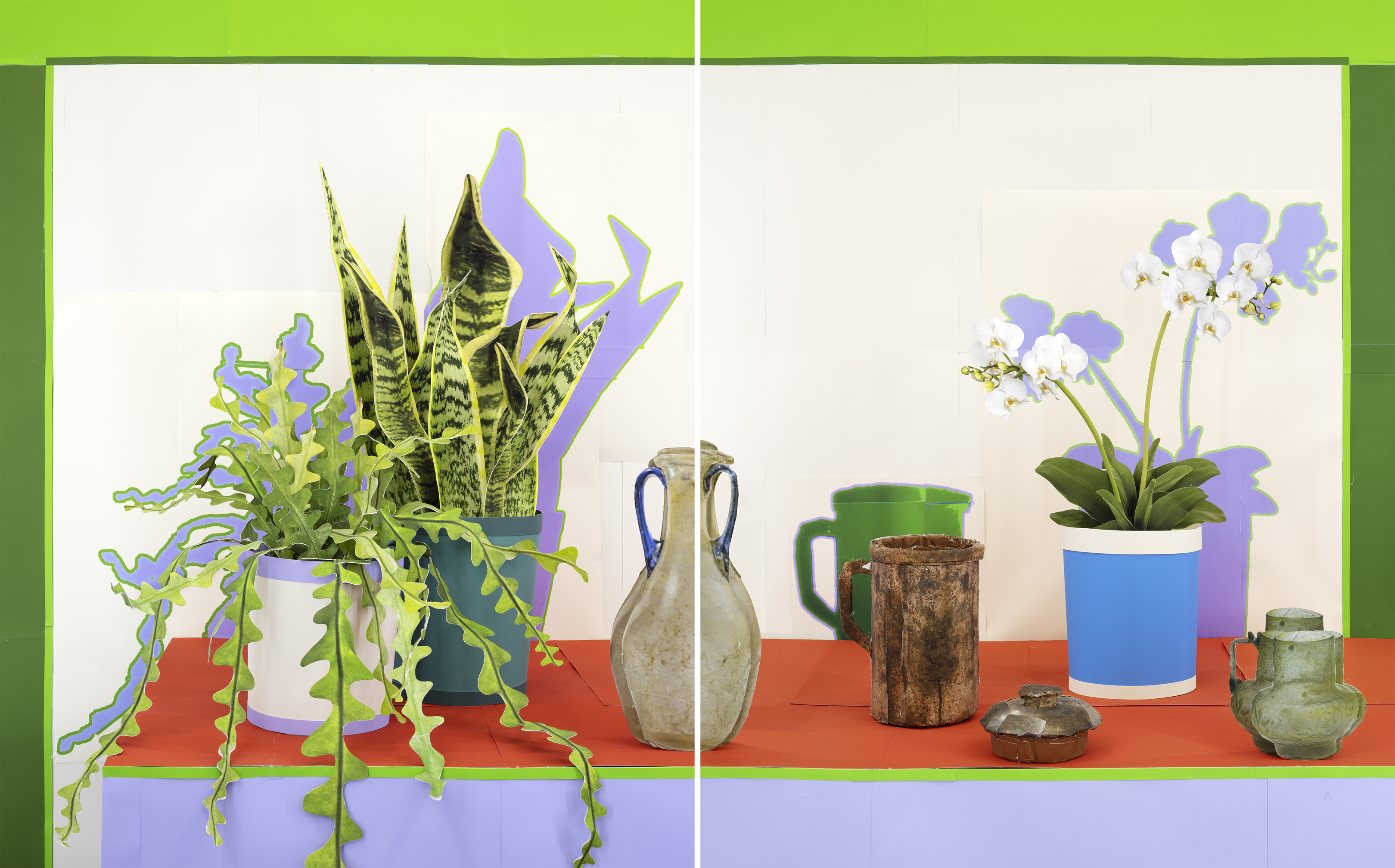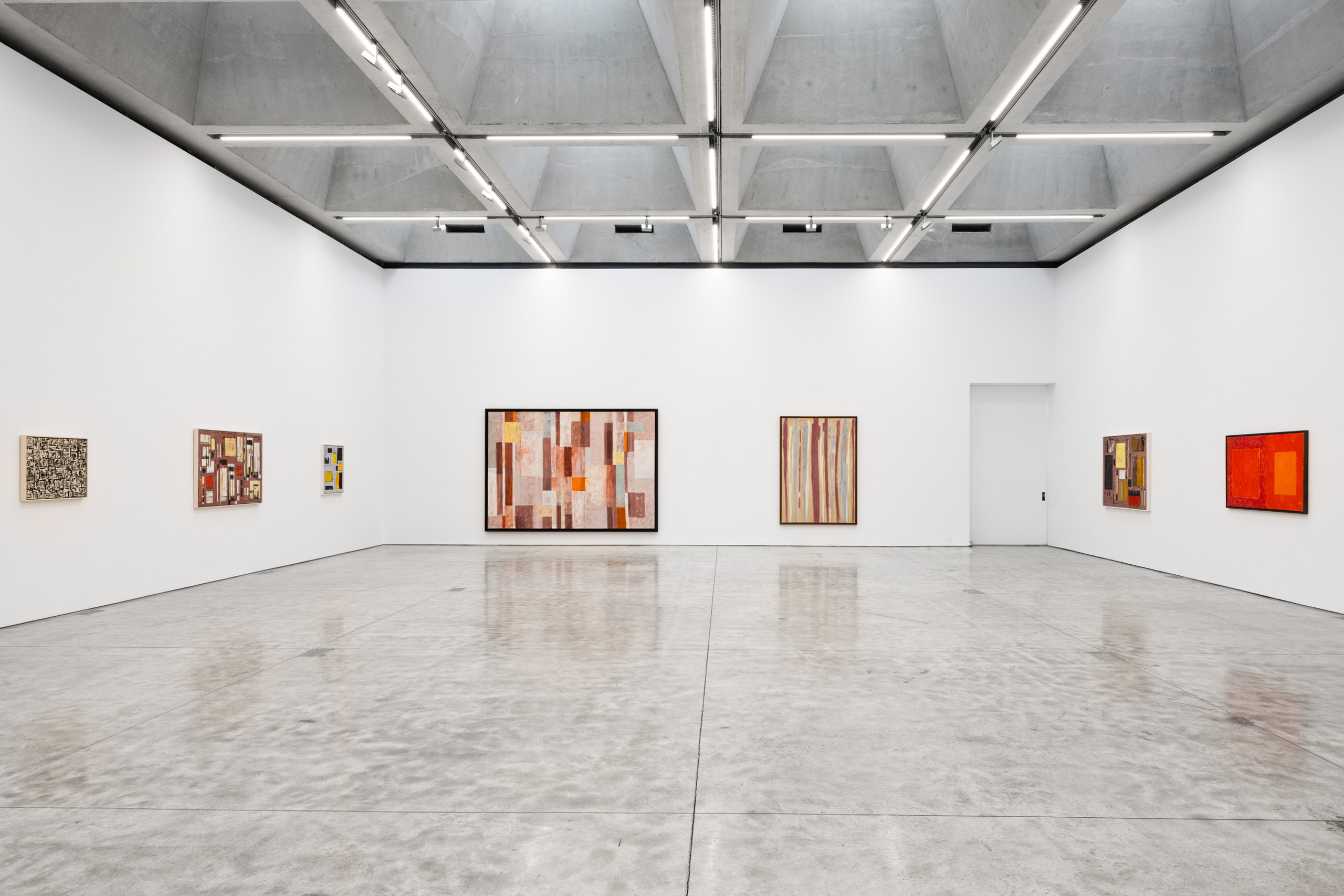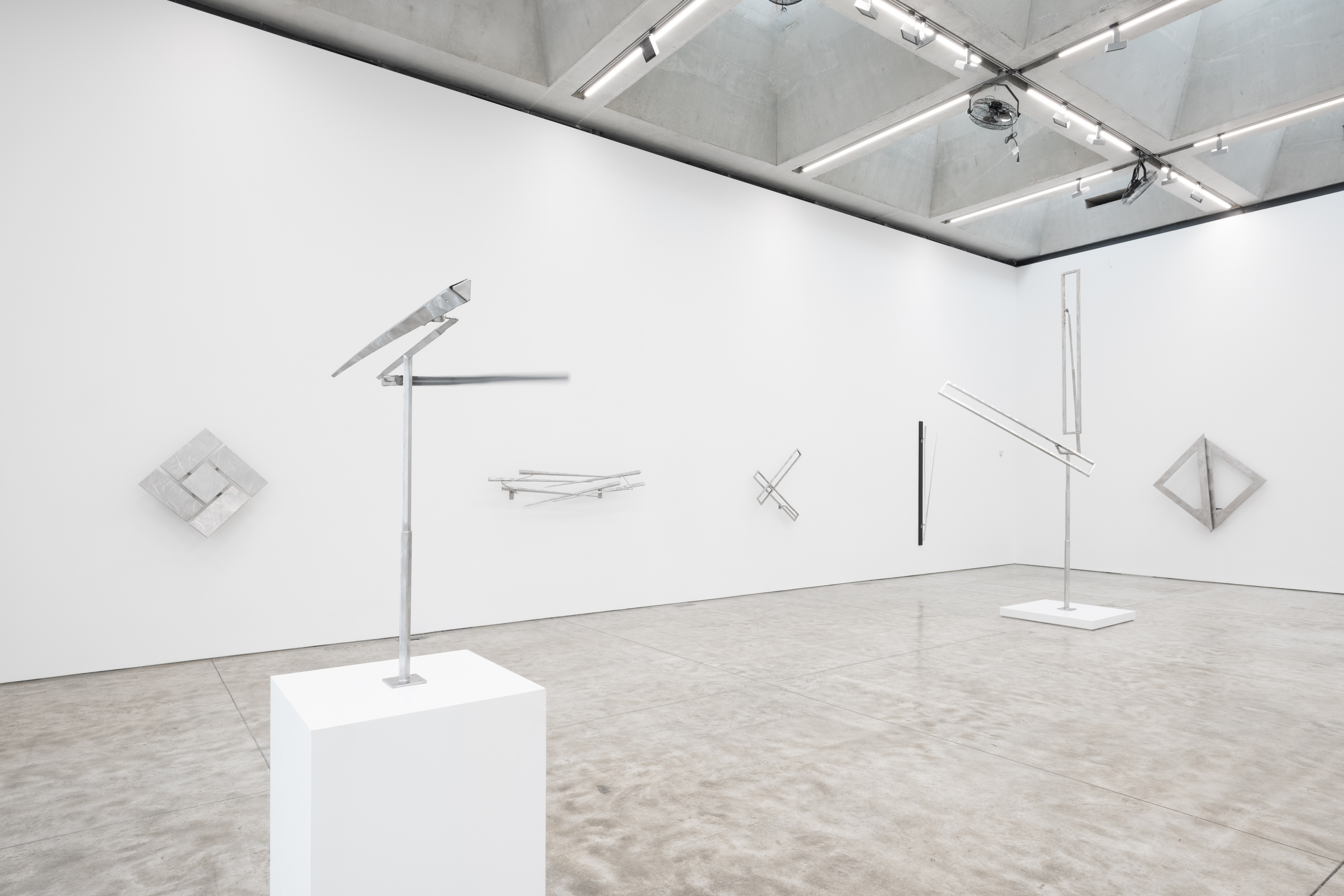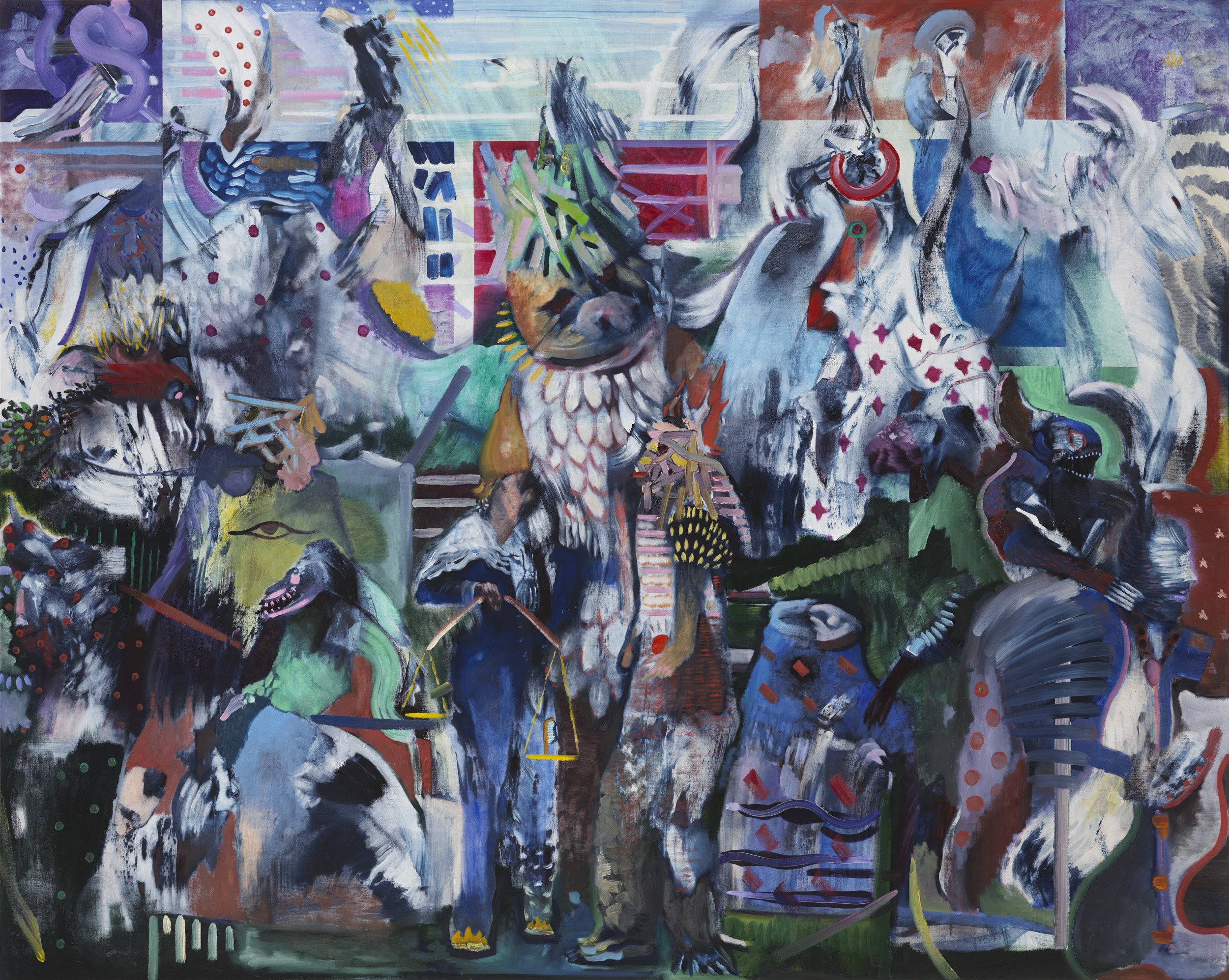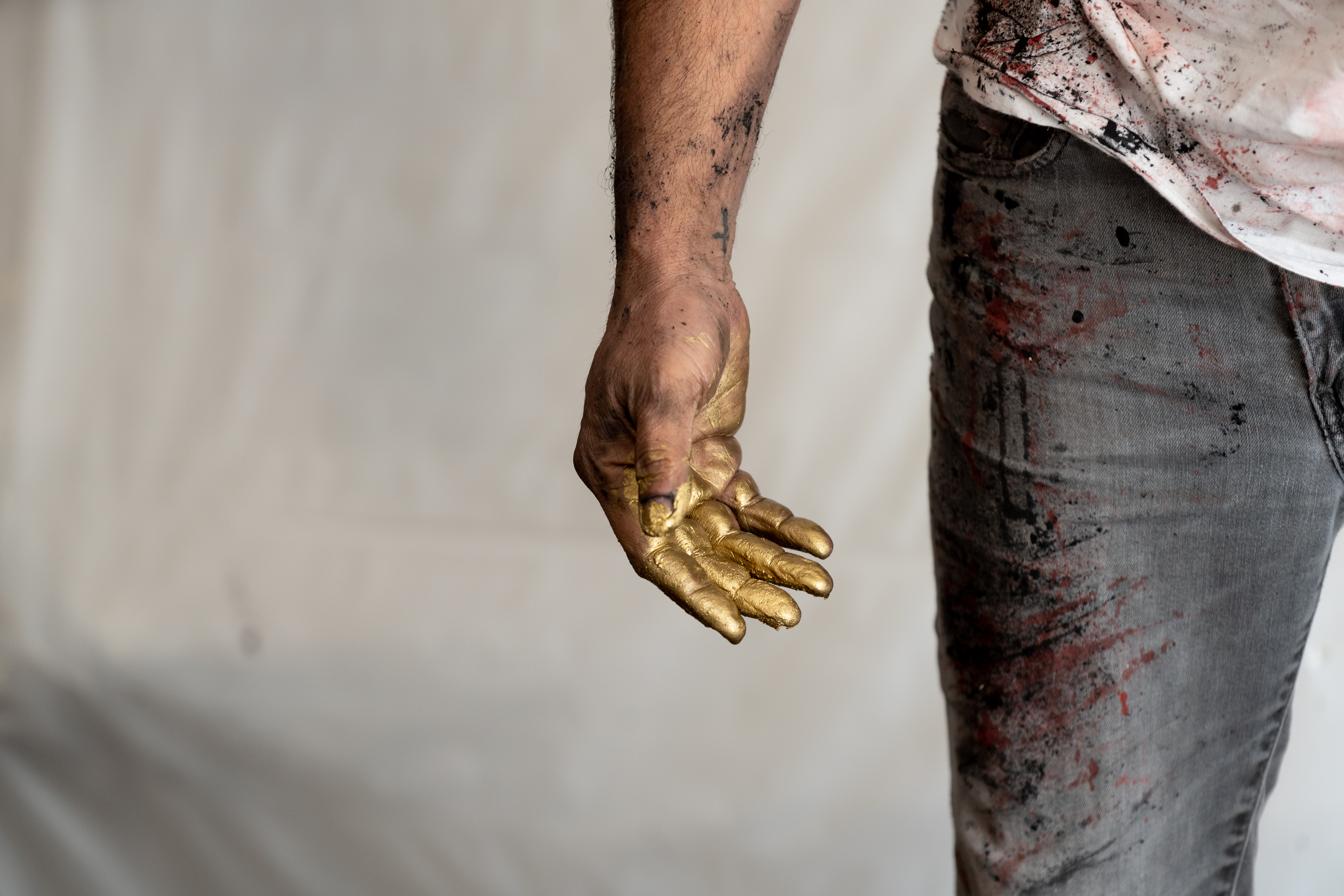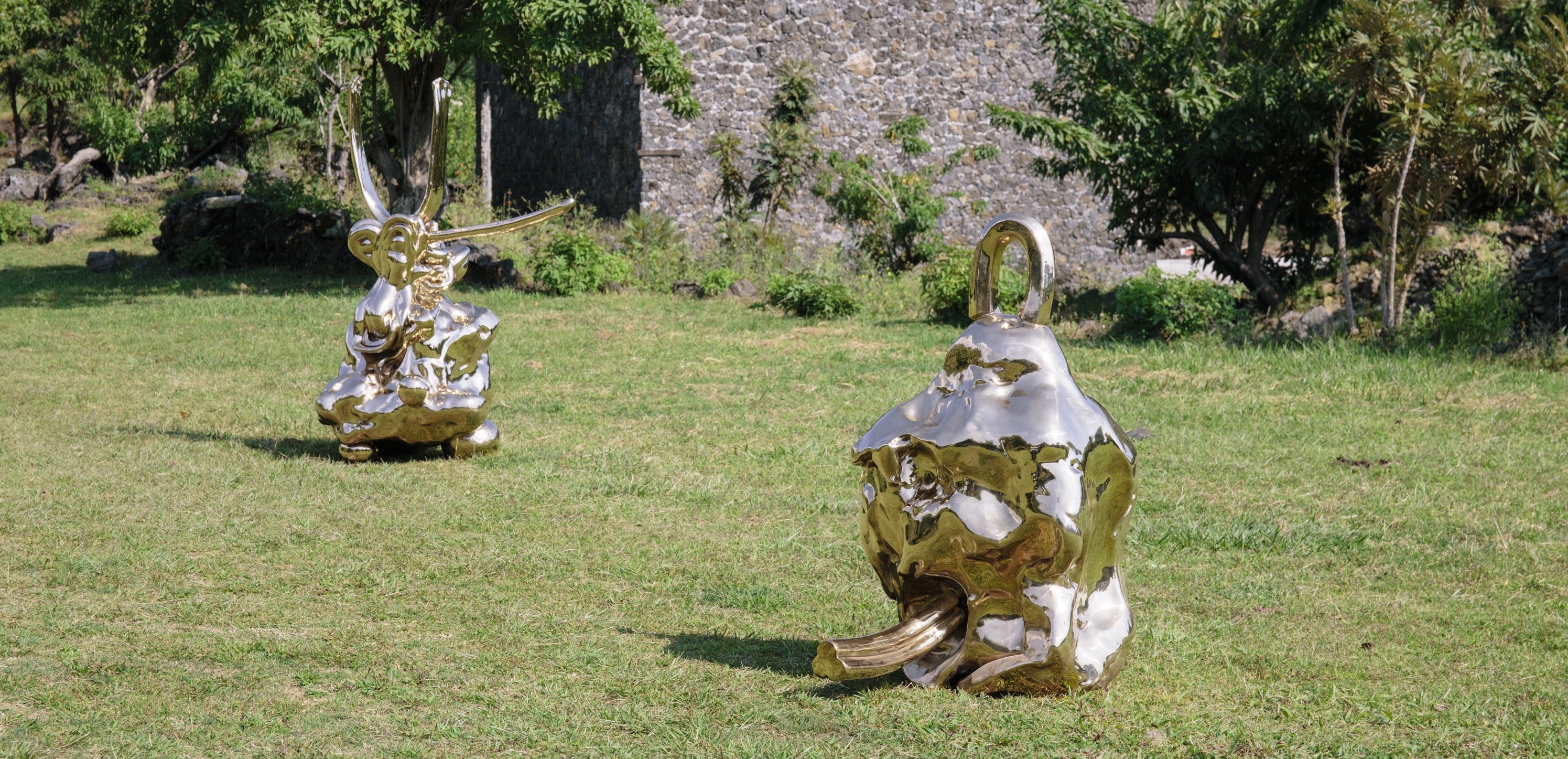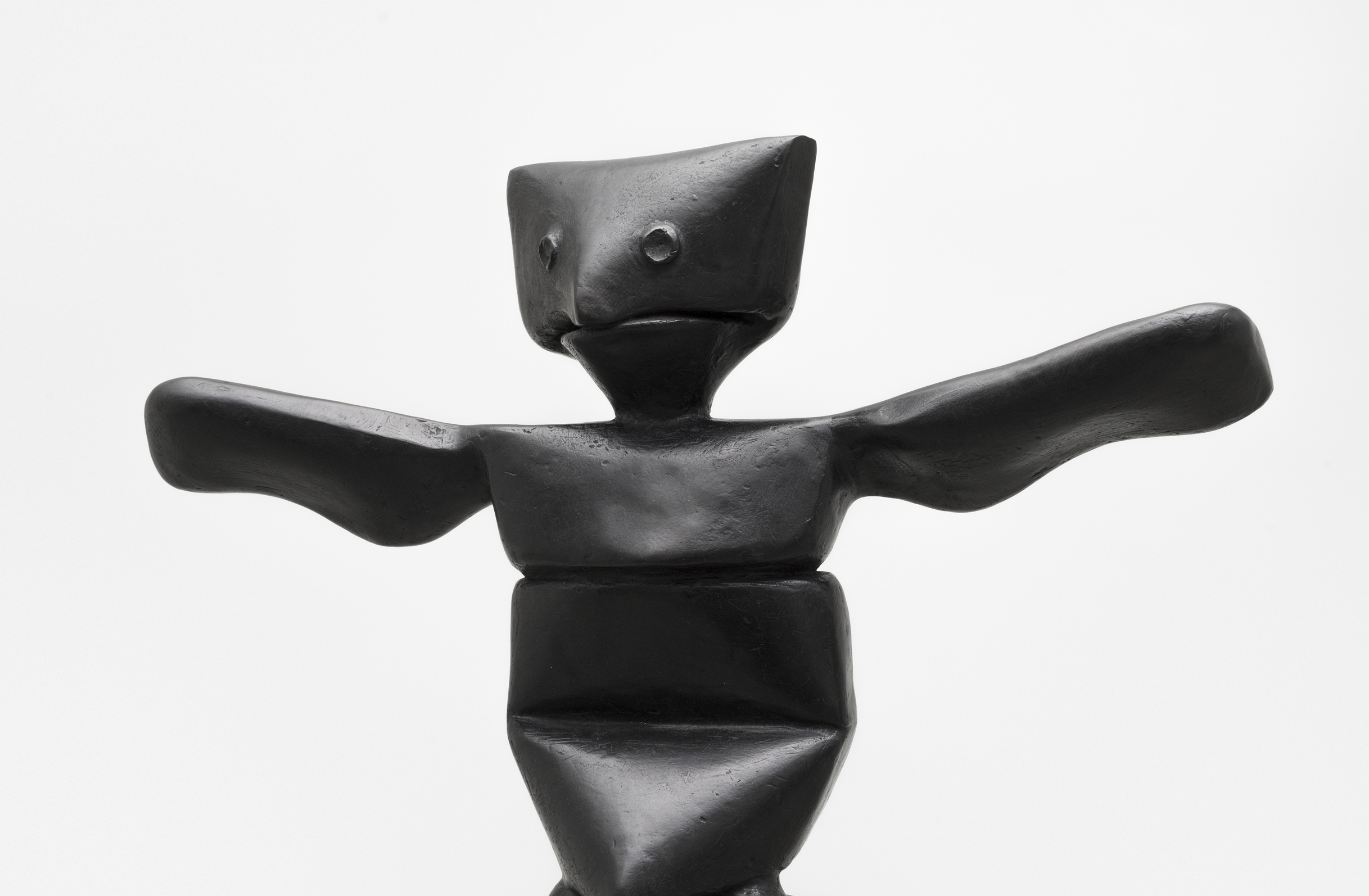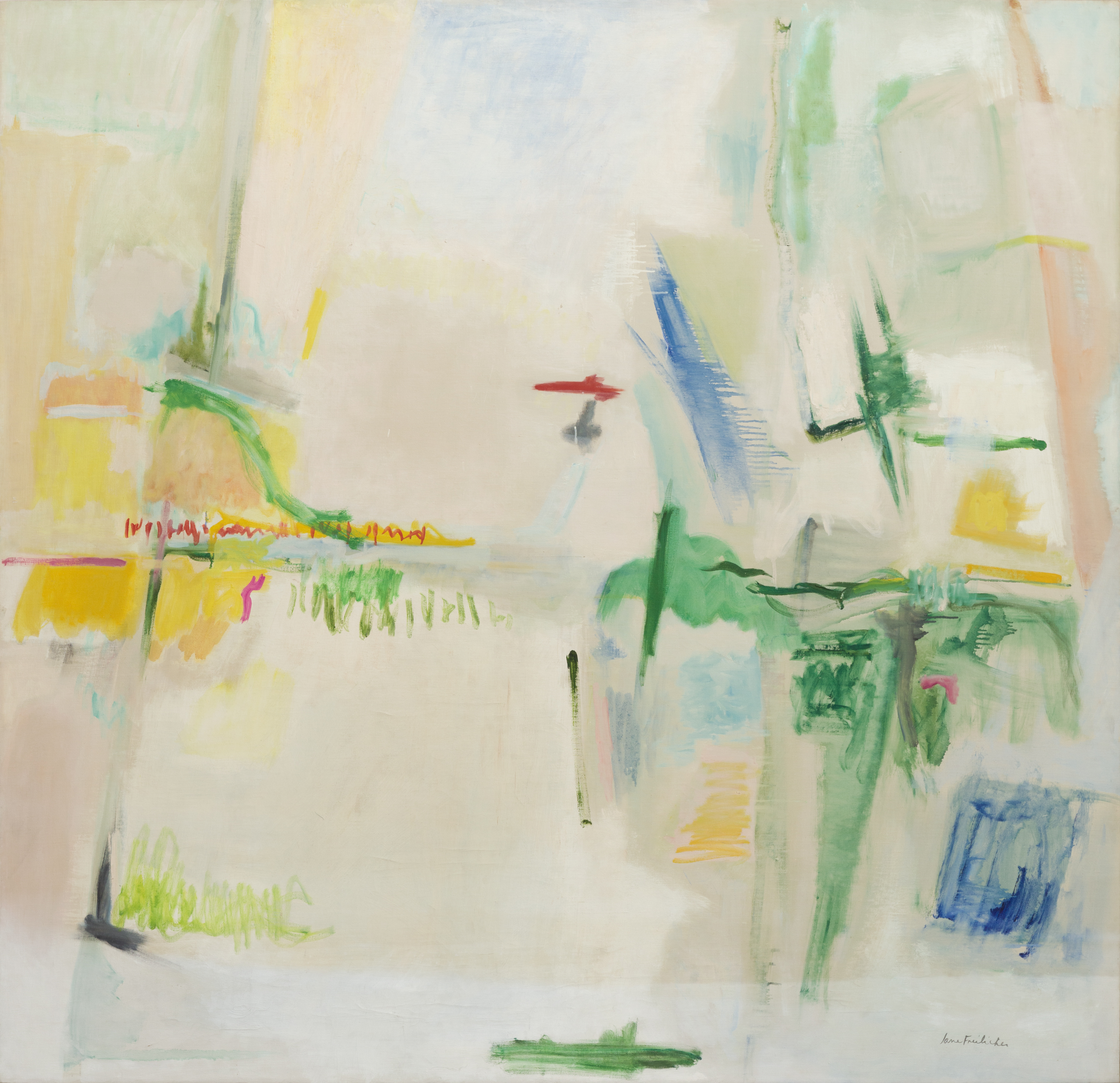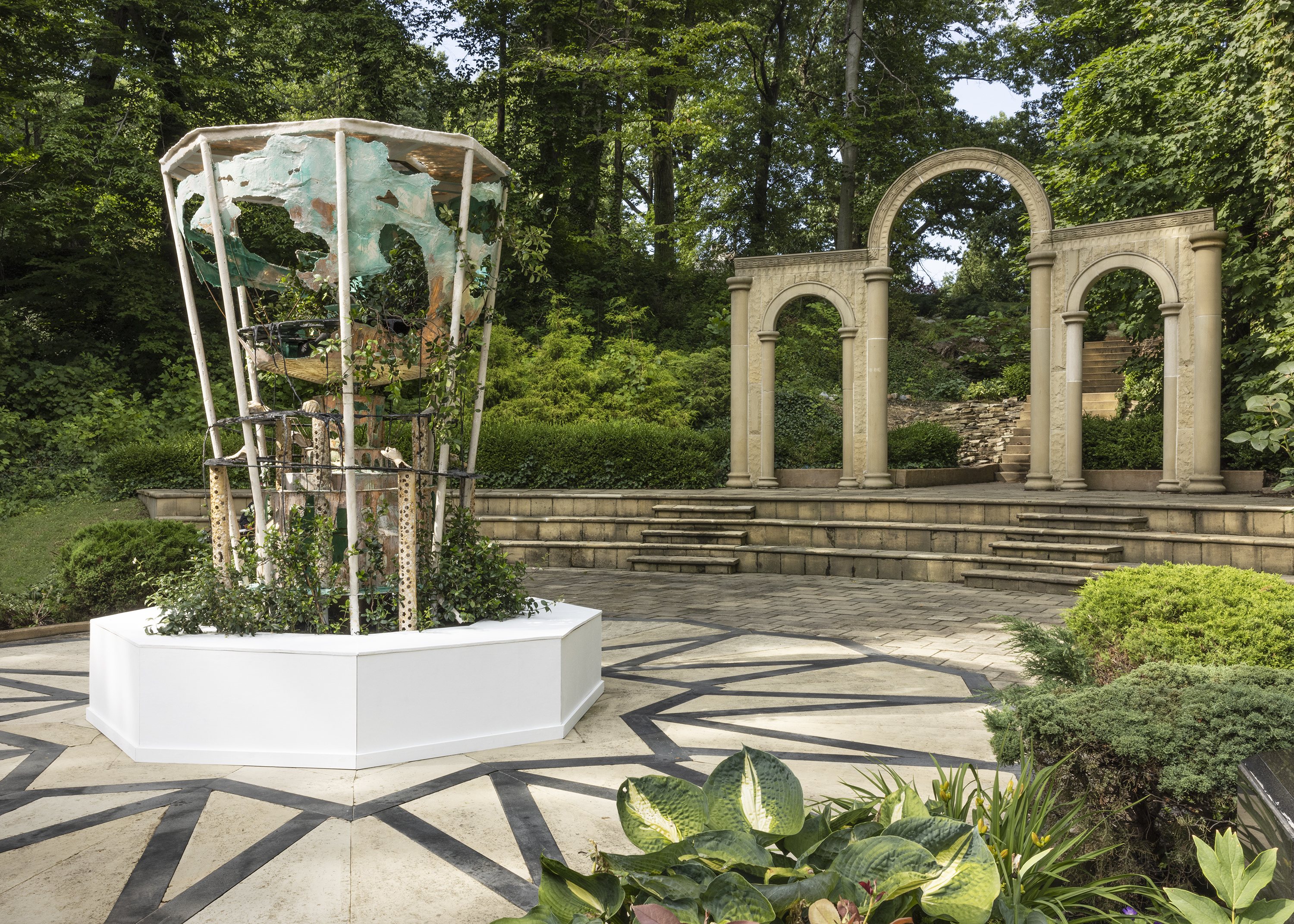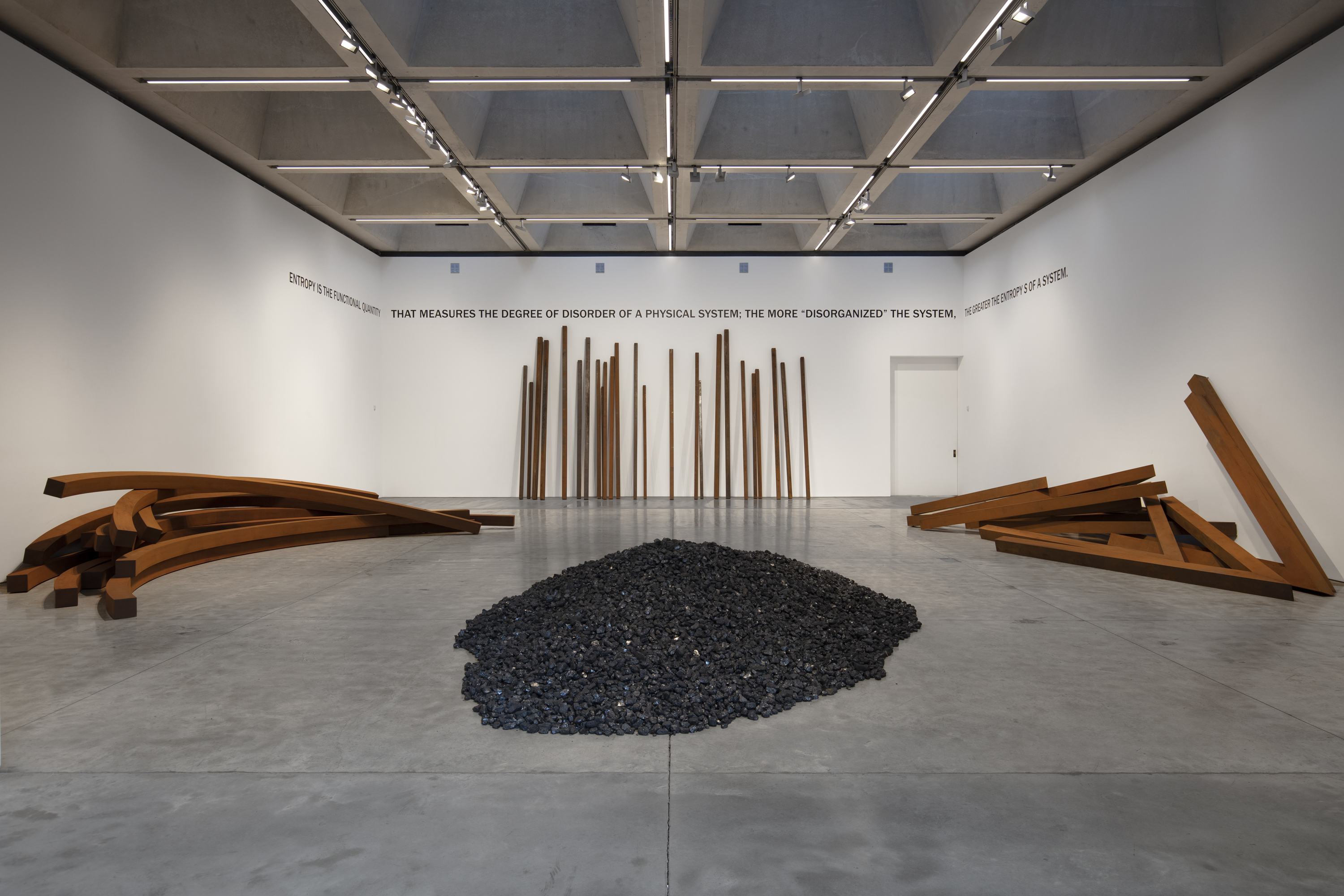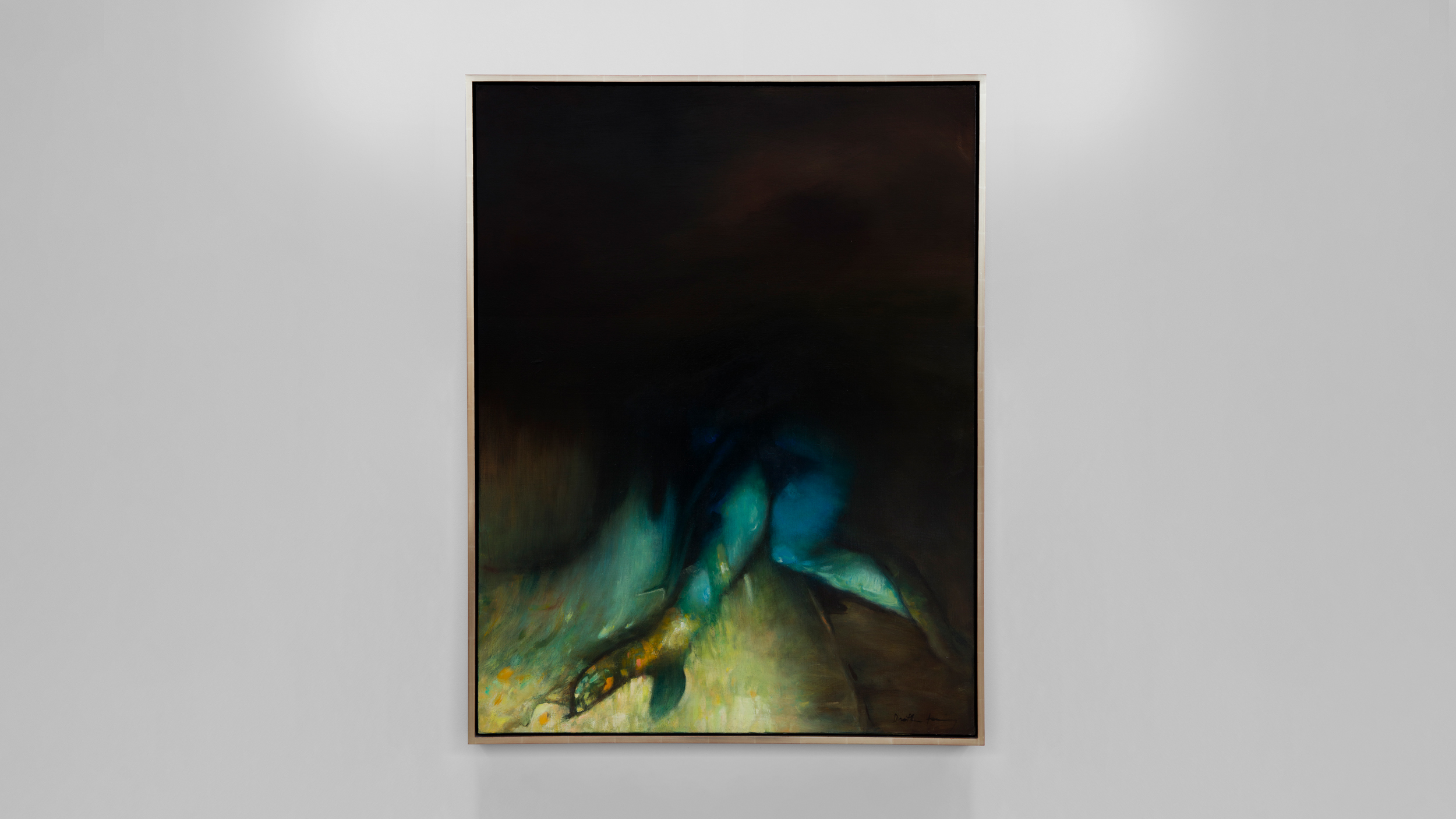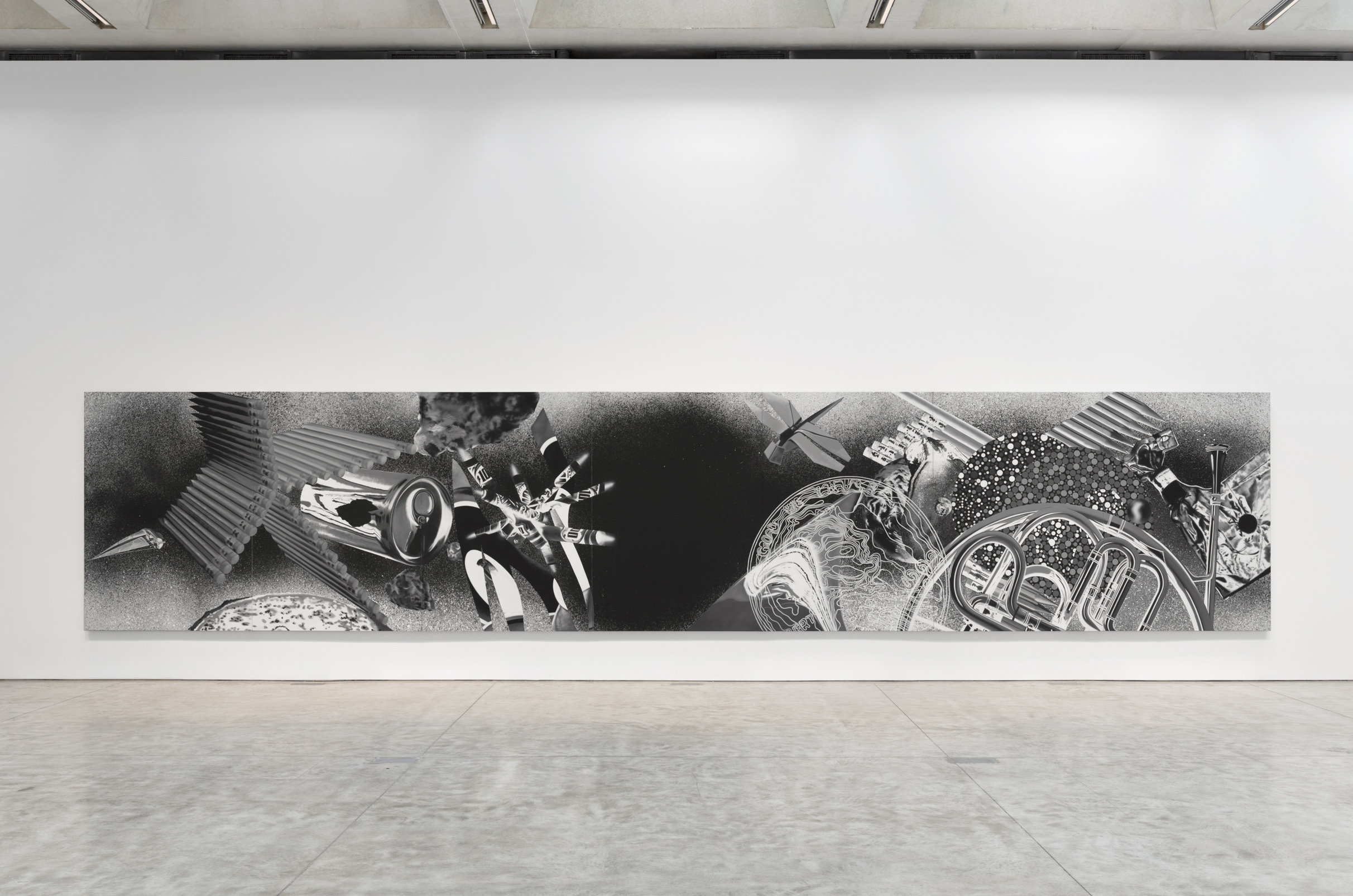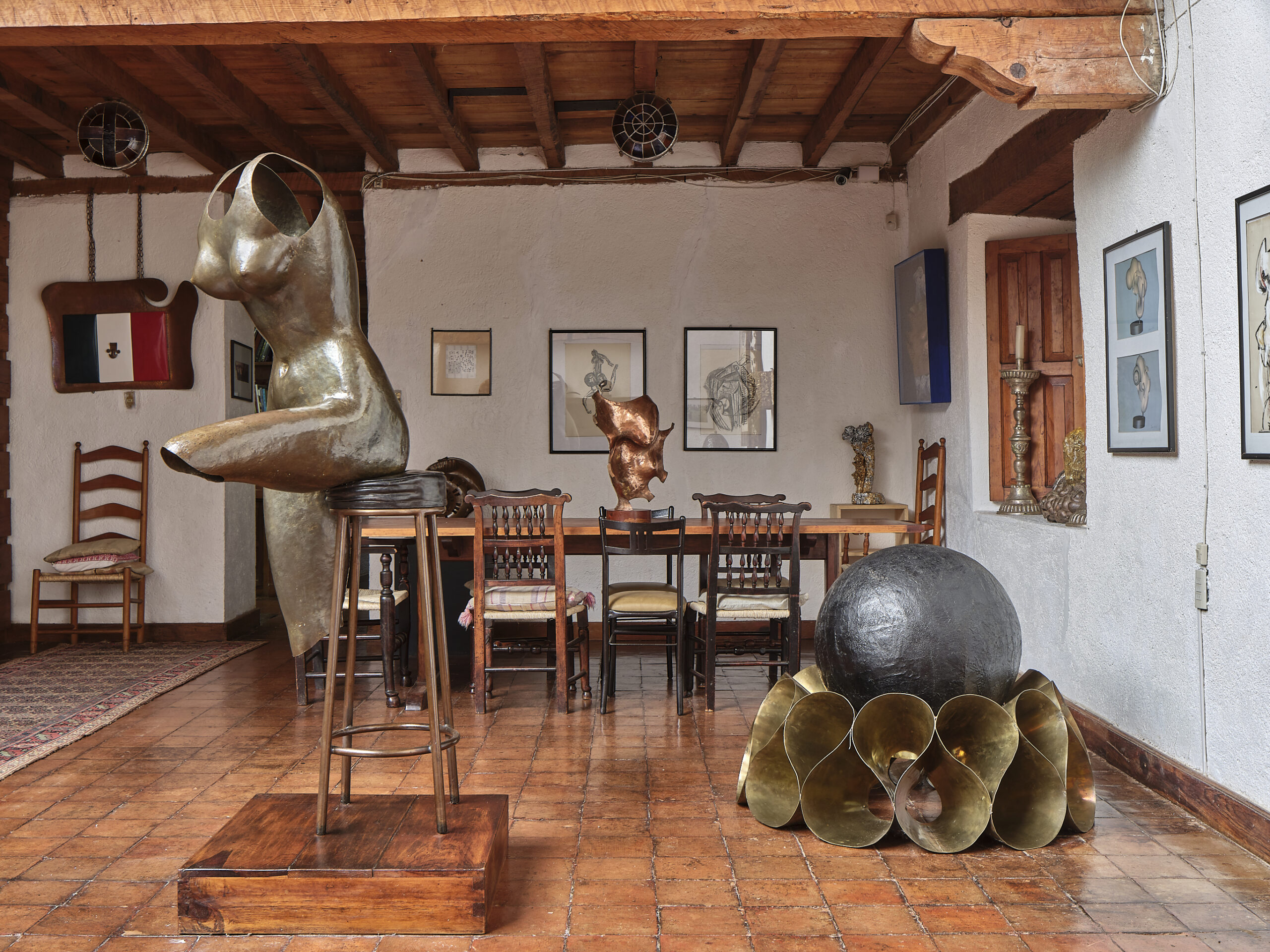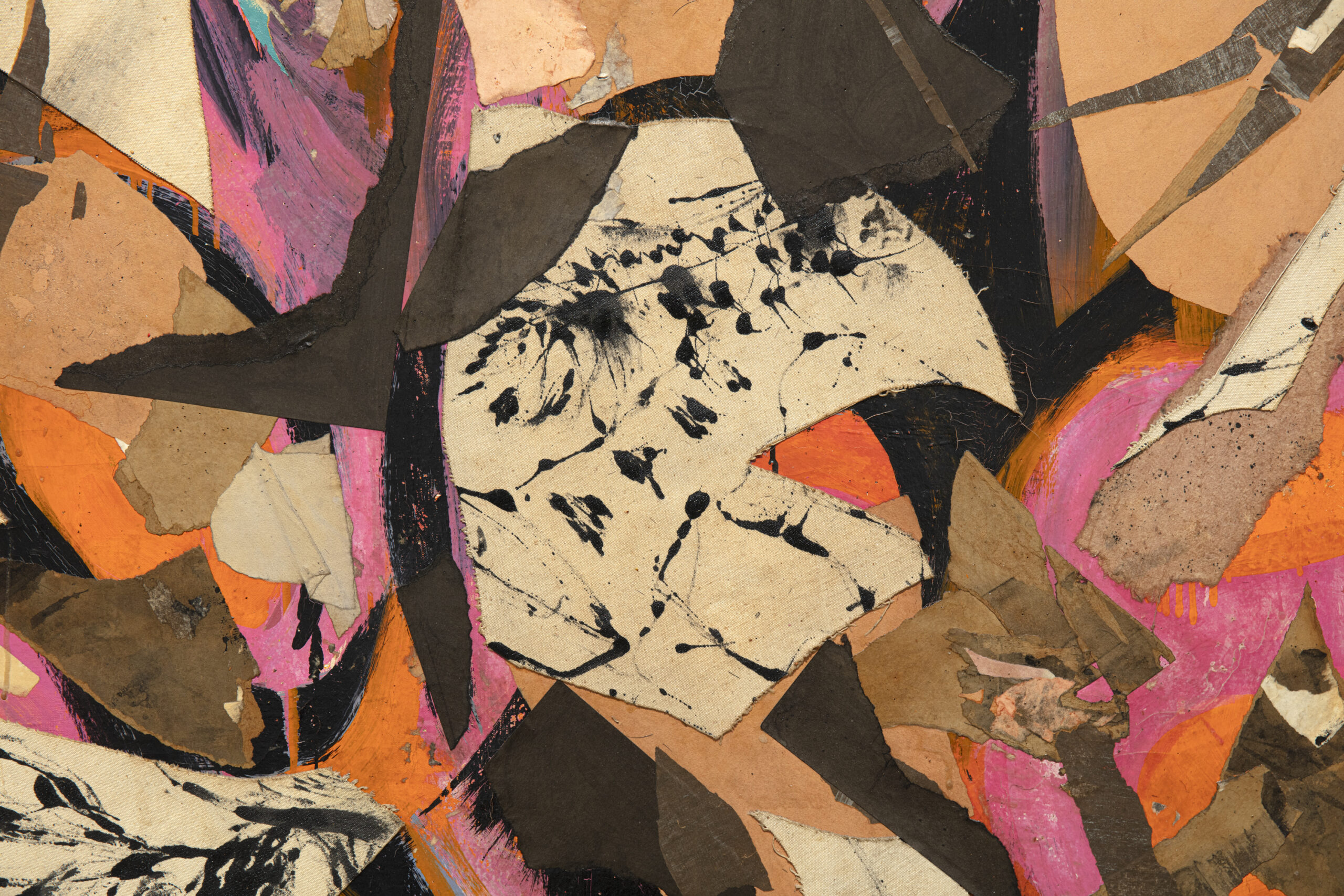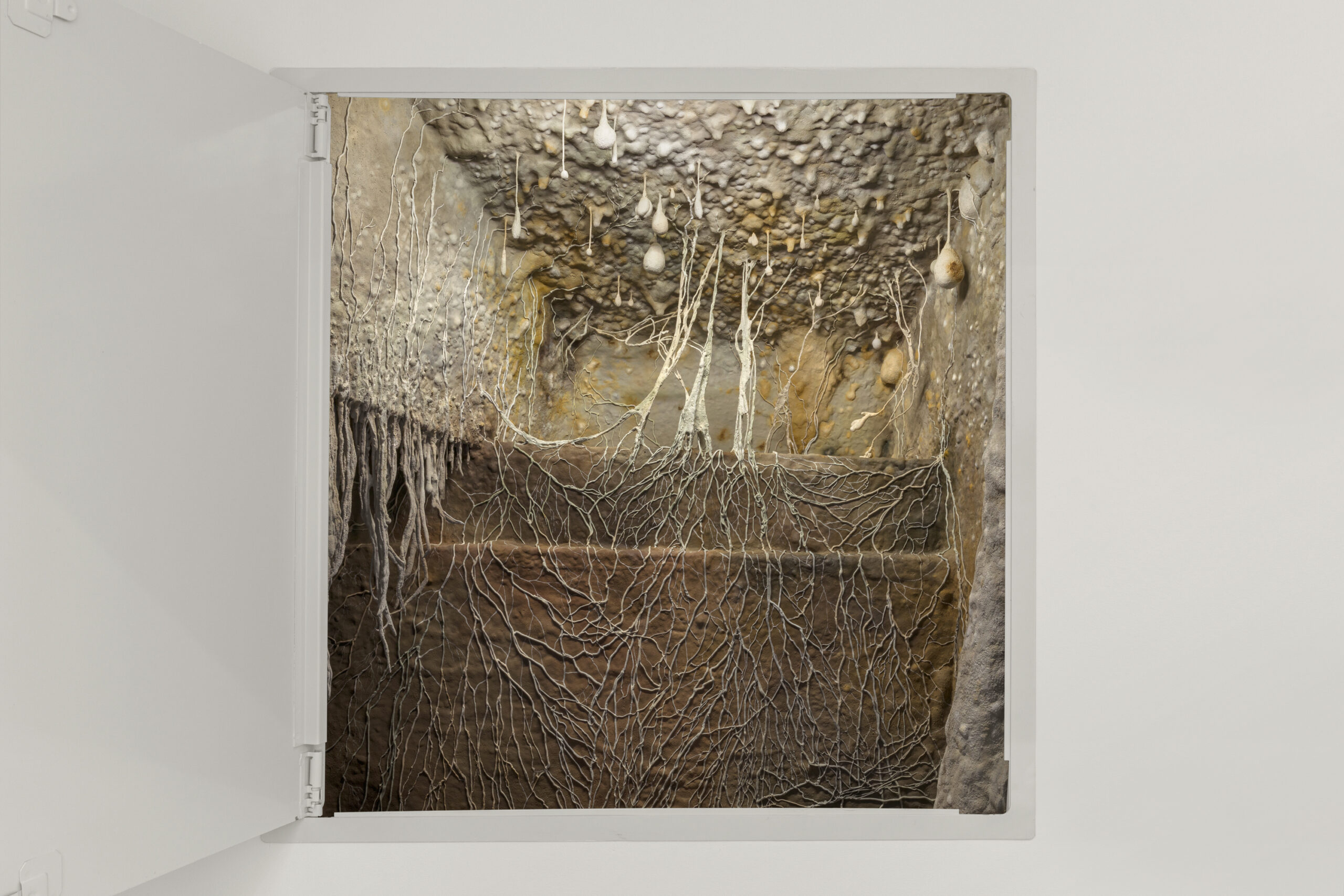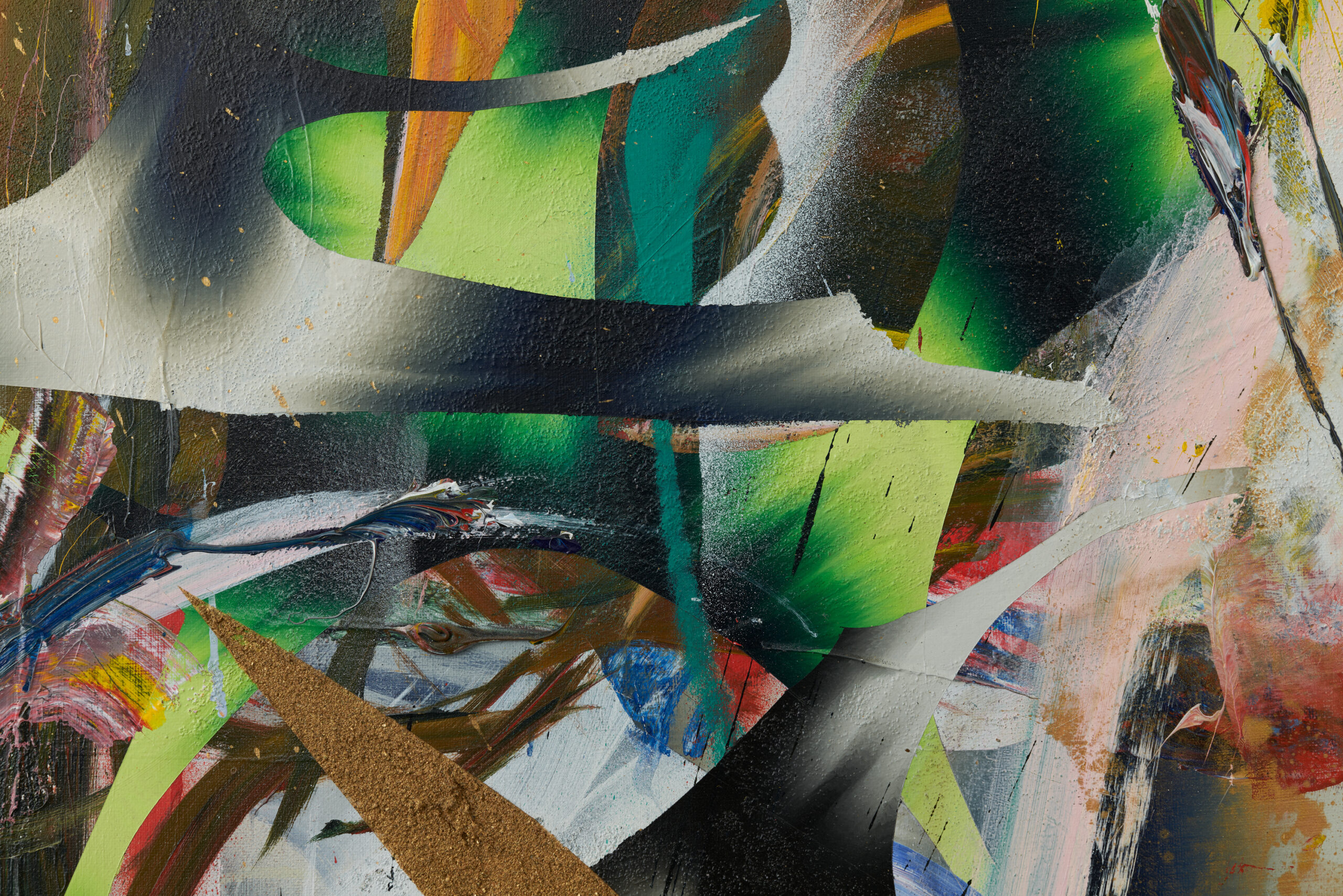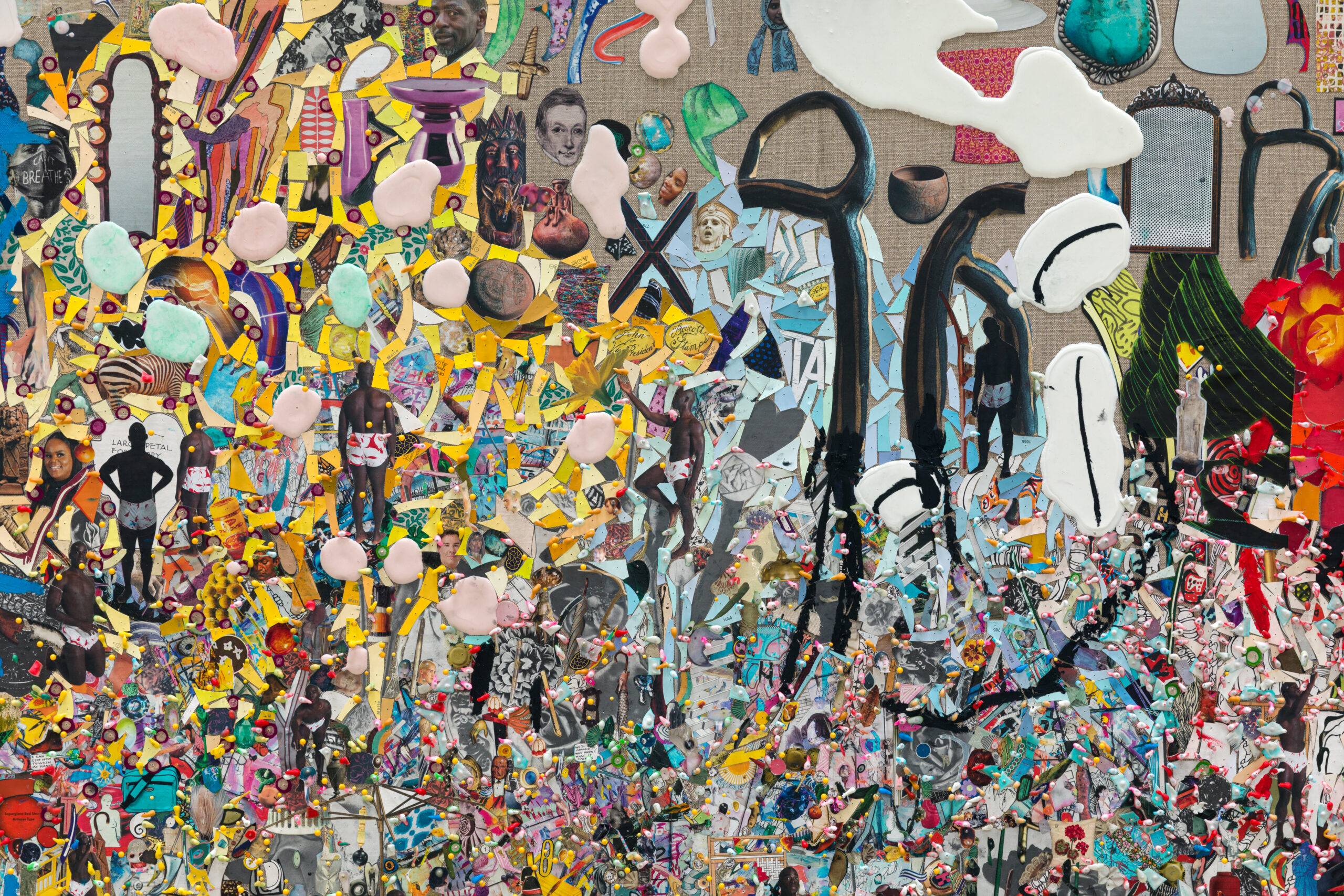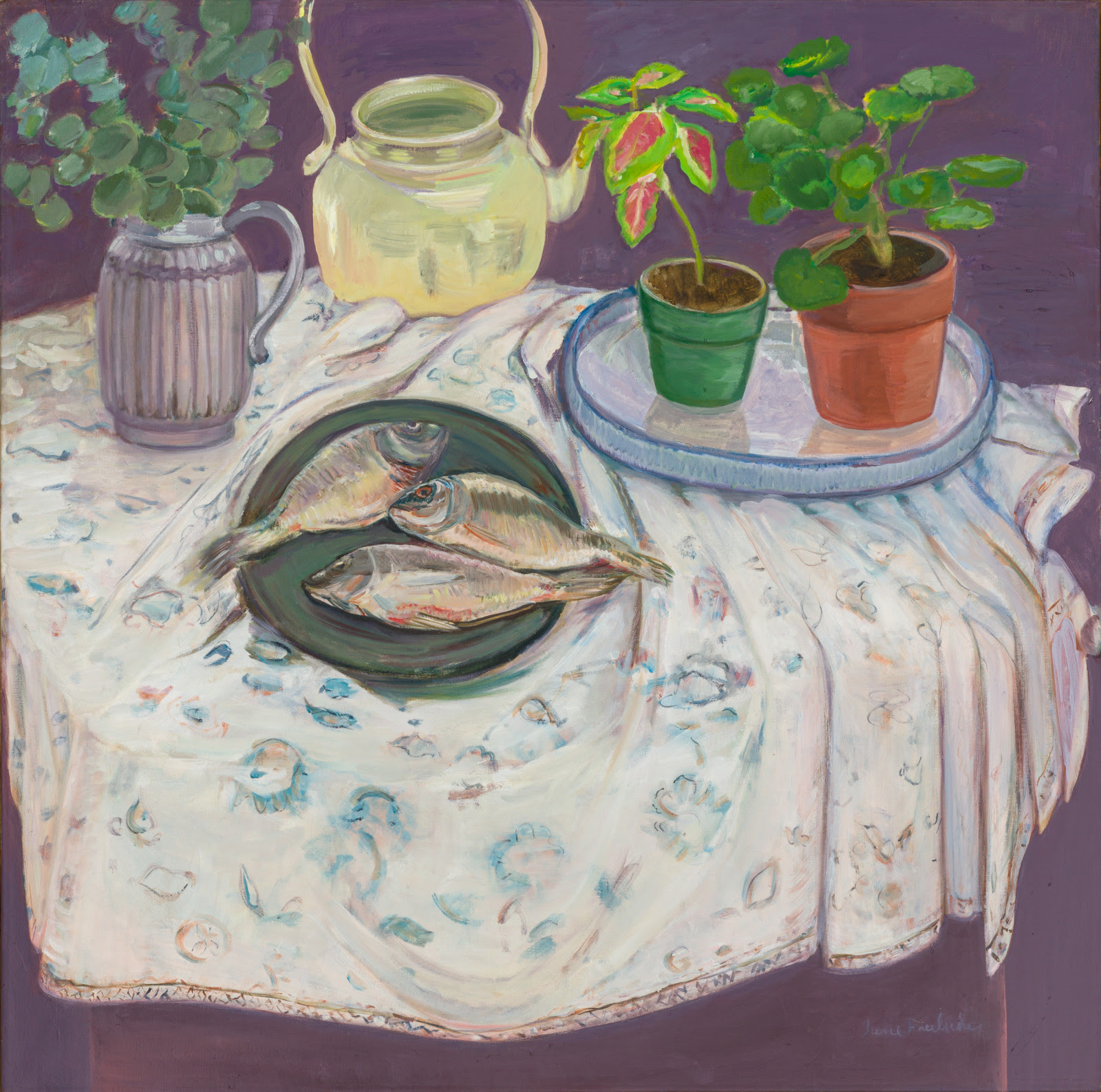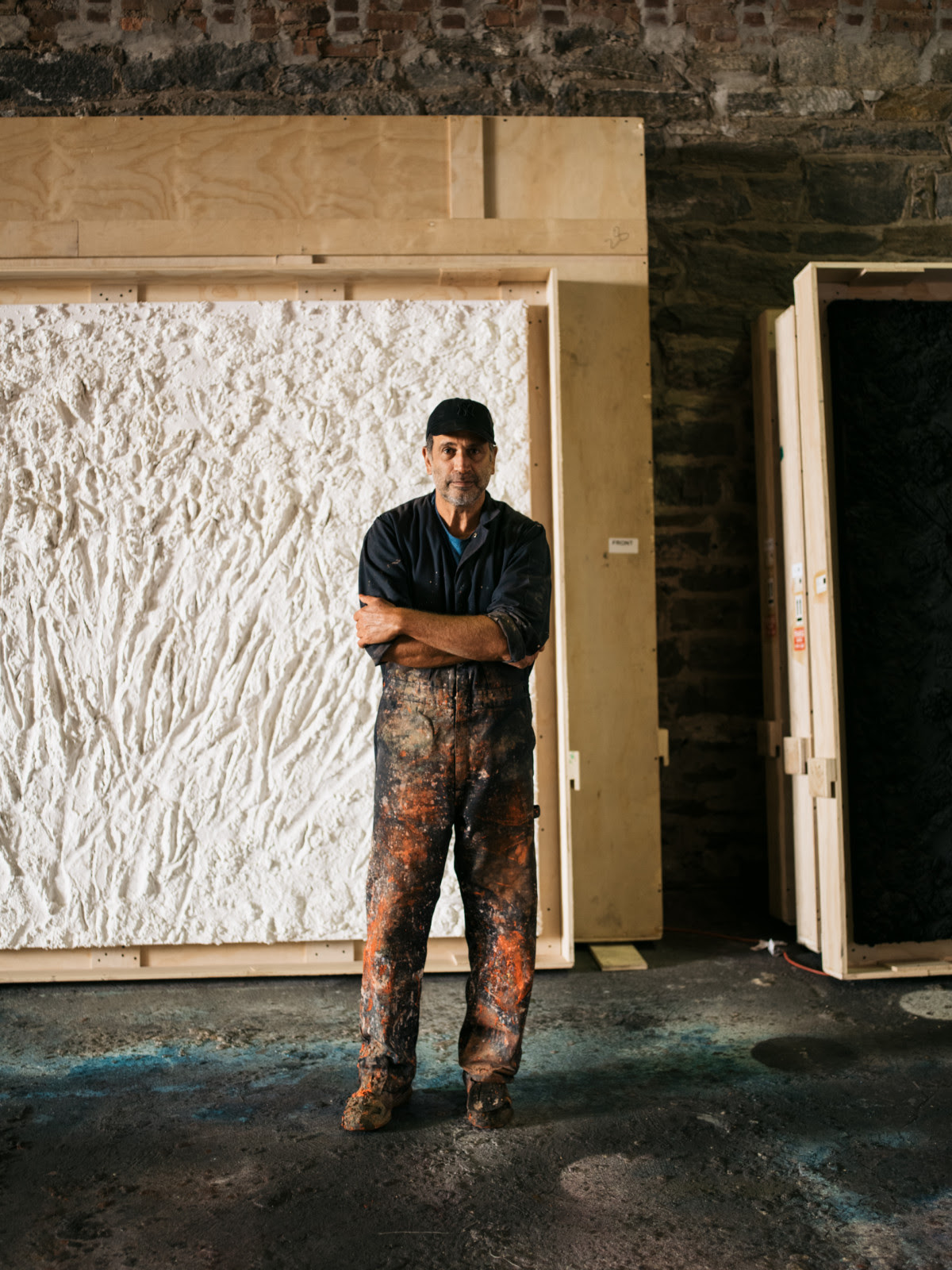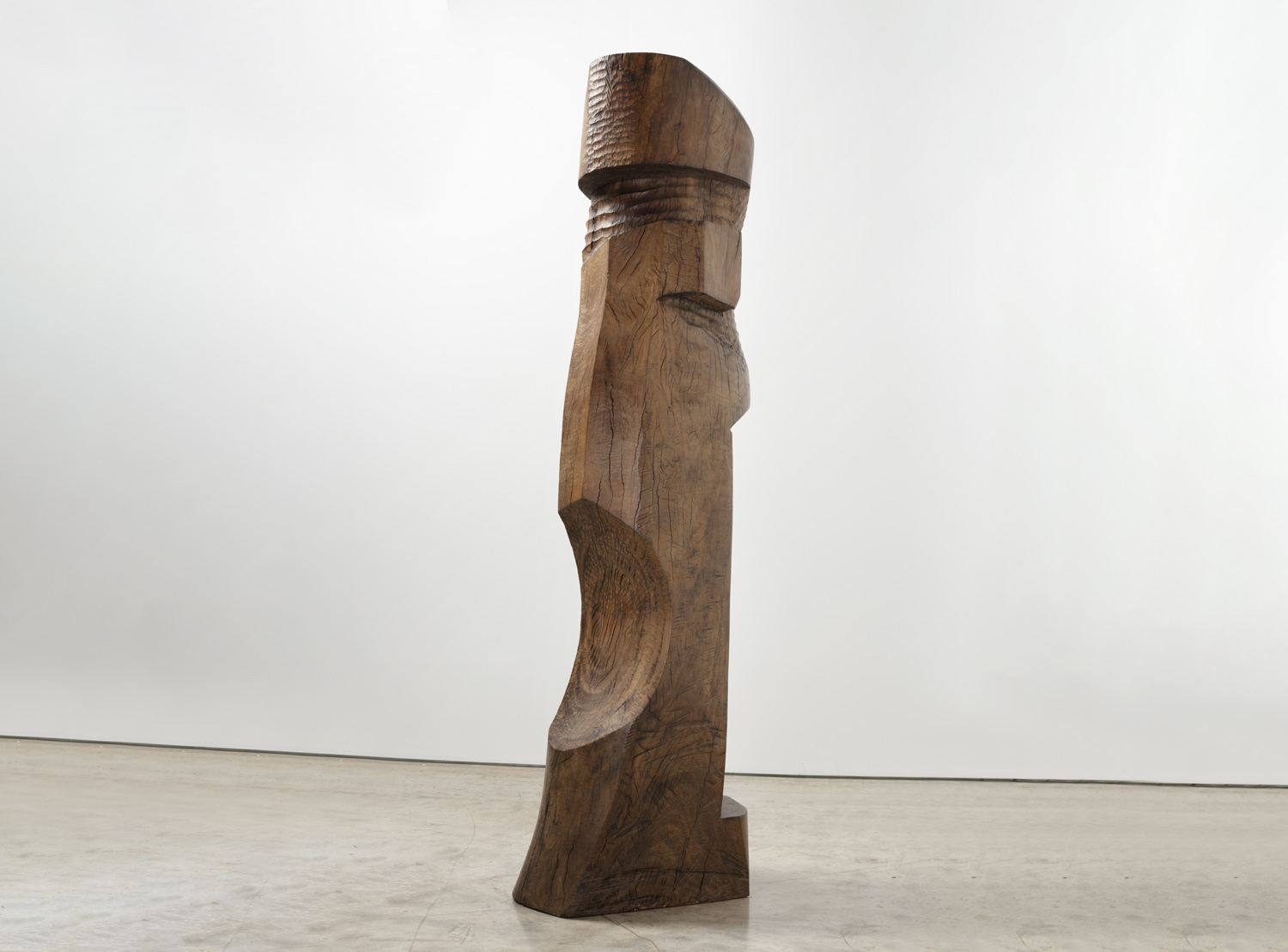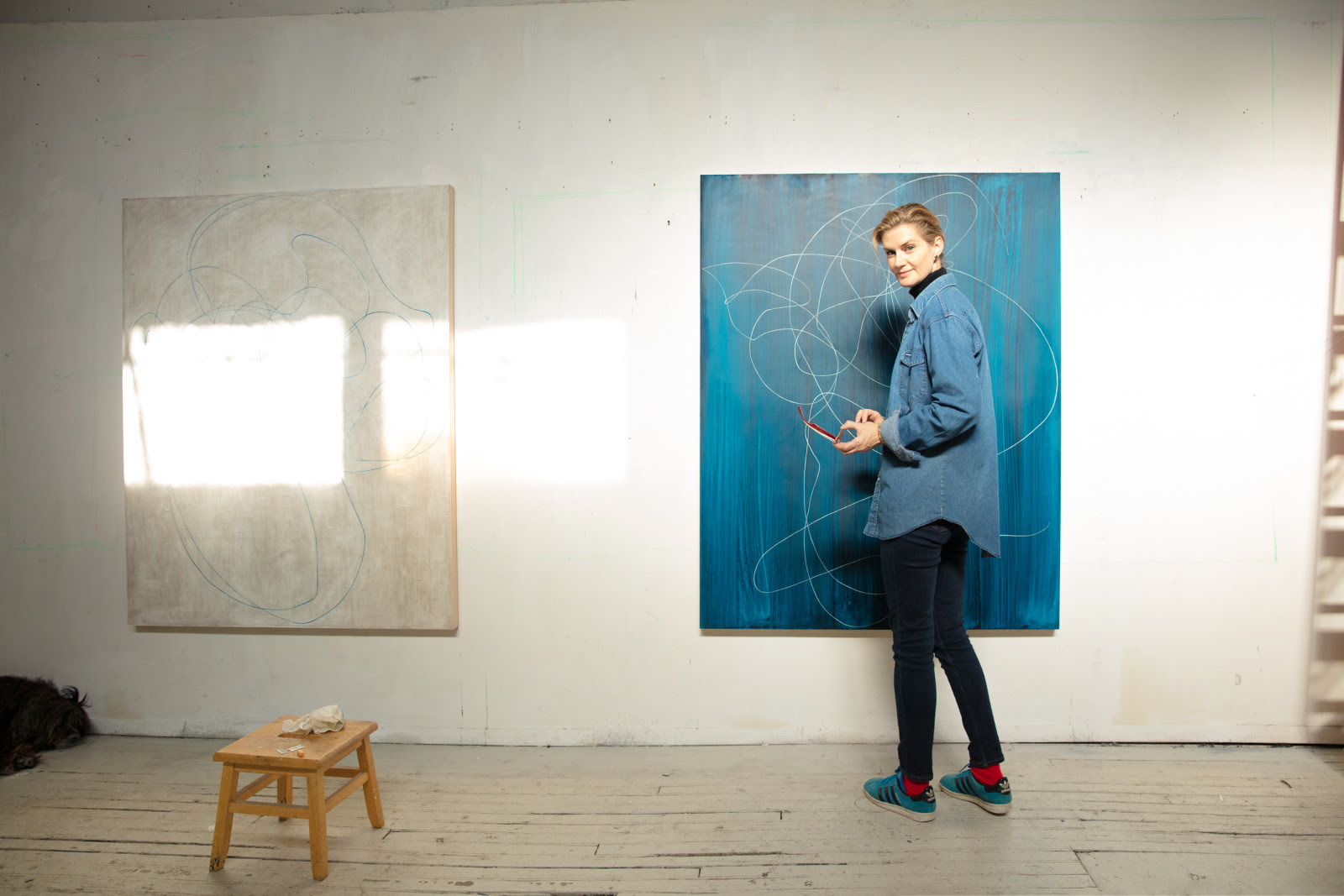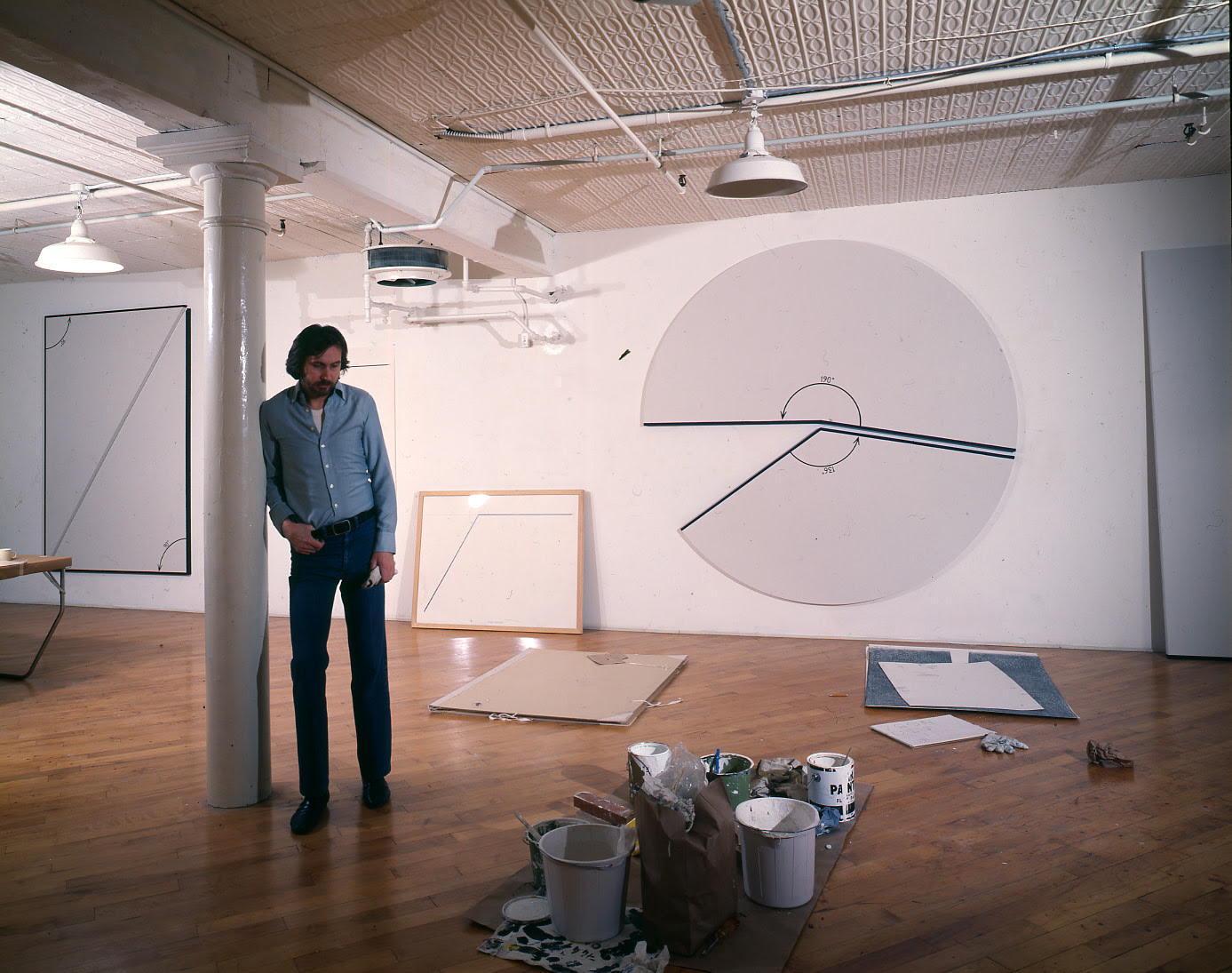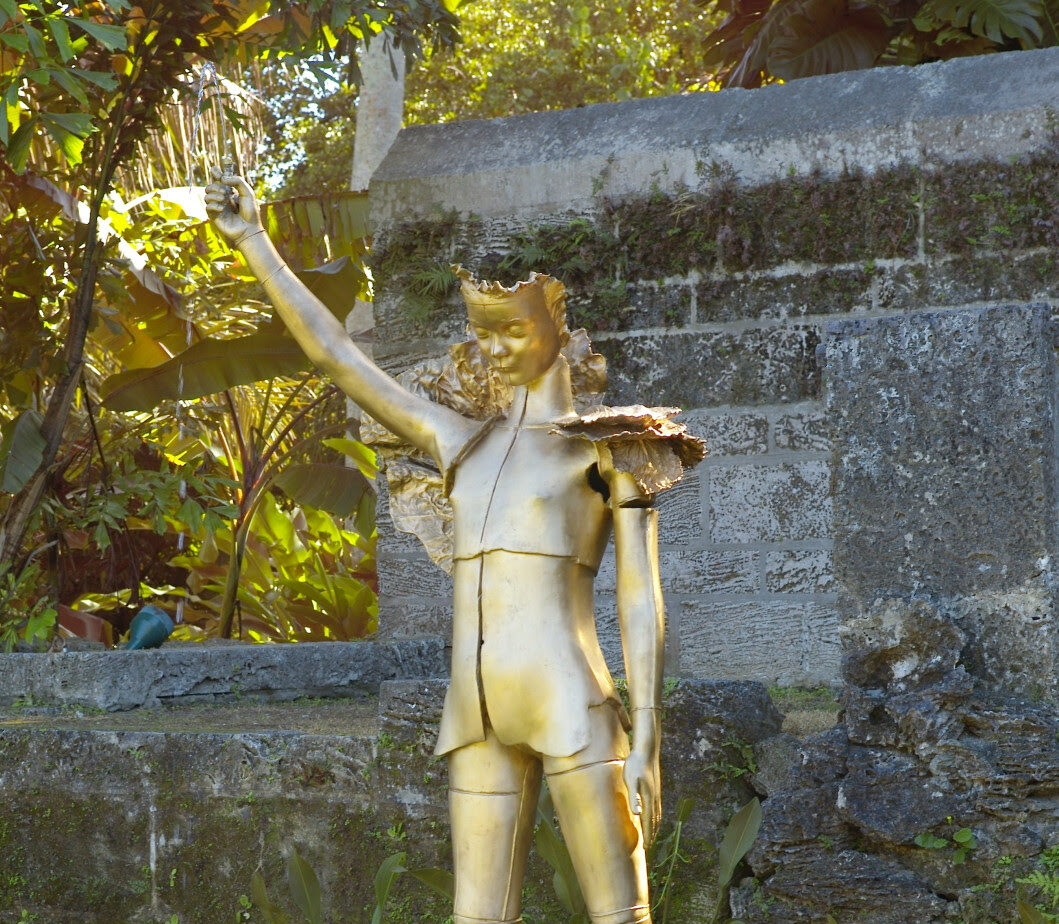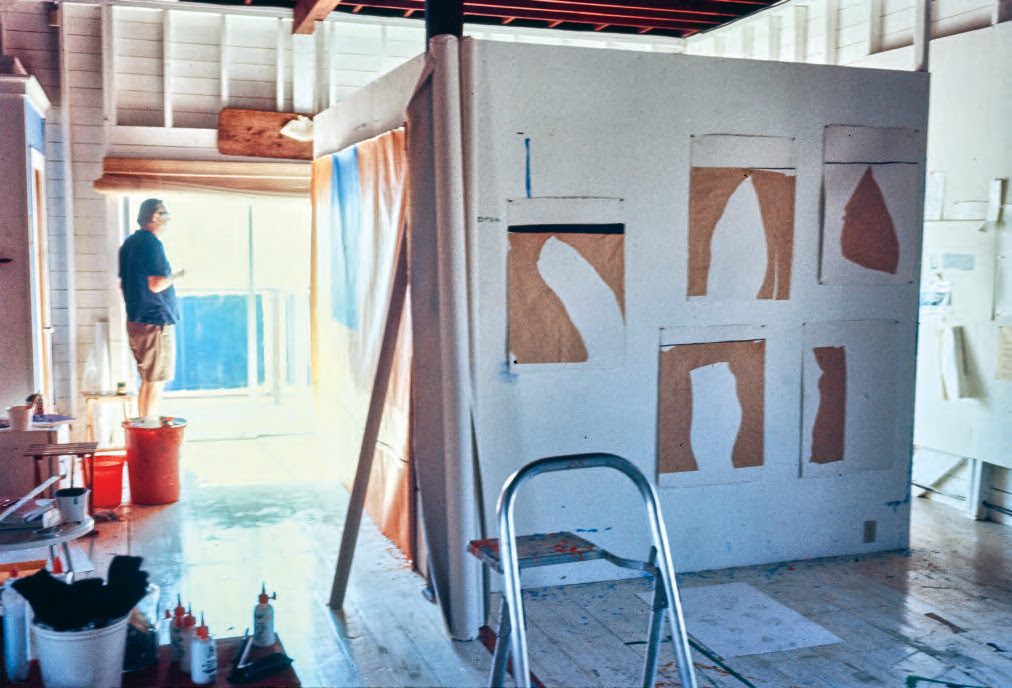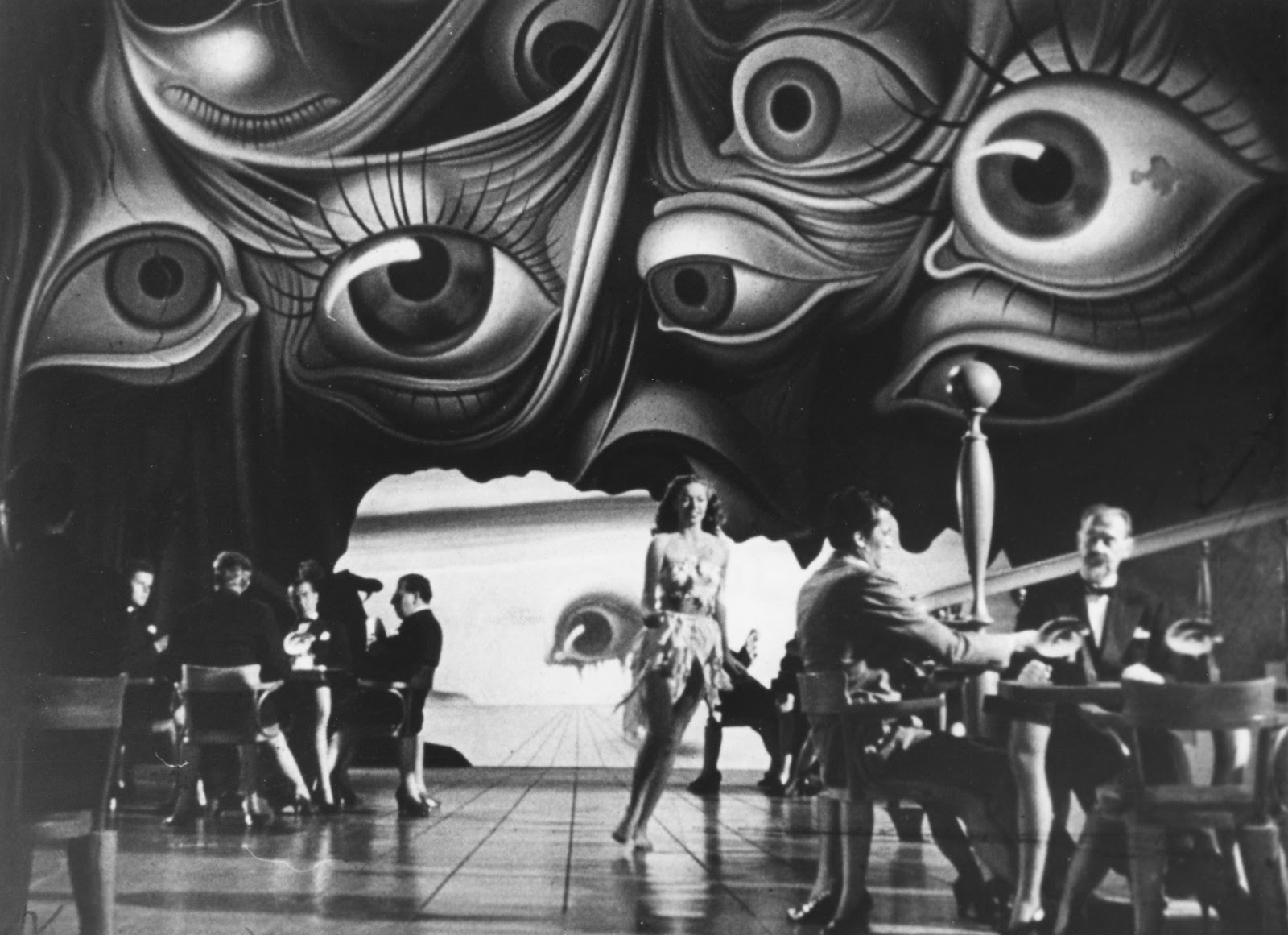On occasional Saturday mornings, Kasmin shares essays and interviews that expand critically on the work and practice of the gallery's artists. This morning's essay on Daniel Gordon by Susan Thompson is published here on the occasion of our current exhibition Daniel Gordon: Free Transform. The essay was originally published in Gordon's most recent and in-depth monograph, New Canvas (2022), from Chose Commune. The exhibition remains on view at 297 Tenth Avenue in New York through June 3.
Daniel Gordon’s work in photography is driven by an avid interest in the slippage between images and objects, and an unrelenting dedication to formal experimentation. Gordon’s richly detailed large-format photographs recast the tradition of the still-life genre in dizzying technicolor compositions that probe the boundaries between surface and depth, digital and analogue, and photography and sculpture.
The foundation of Gordon’s practice is a multilayered process of image construction. In the studio, the artist stages tabletop tableaux comprised of objects that are themselves fabricated out of images. The items featured are standard still-life fare: intentionally generic fruits, impossibly perfect flowers, and a variety of vases and vessels. Largely sourced online through Google searches, these images are printed out, cut, and pasted into multi-dimensional arrangements created specifically for the camera. The resulting photographs are pictures of objects made out of pictures. Though Gordon’s primary endeavor is making photographs, he ends up making a lot of sculpture along the way, using images to sculpt. Producing an uncanny effect, this tension between two- and three-dimensionality hums at the heart of Gordon’s project.
Many items featured in Gordon’s scenes are constructed from multiple print-outs of the same image, which are crumpled and layered over one another to form volumetric shapes. These assemblages of image-objects come together in still-life arrangements of varying scale and complexity; some works feature a single plant or modest grouping of fruit while others are more expansive and densely populated. At first glance, the repeated, overlaid images give an impression of digital glitch, as if these scenes are perhaps compiled via a digital copy/paste function; the items exhibit dimensionality, but no real sense of mass or heft. (See the apples in Still Life with Pitcher and Apples [2013], each of which has redundant stems. [1]) Though Gordon is interested in that initial moment of disorientation where the viewer is unsure of what they’re seeing, he is not attempting to trick the viewer or achieve a full trompe l’oeil effect. Little effort is made to hide the material reality of the objects’ making; they are visibly hand-crafted, their seams, folds, and torn edges readily apparent. [2] The pronounced crumpling of the vase in Zinnias (2011), for example, announces itself undoubtedly as paper, while the potted plant featured in the early work July 5, 2009 (2009) bears conspicuous strings of residual glue-gun polymer.
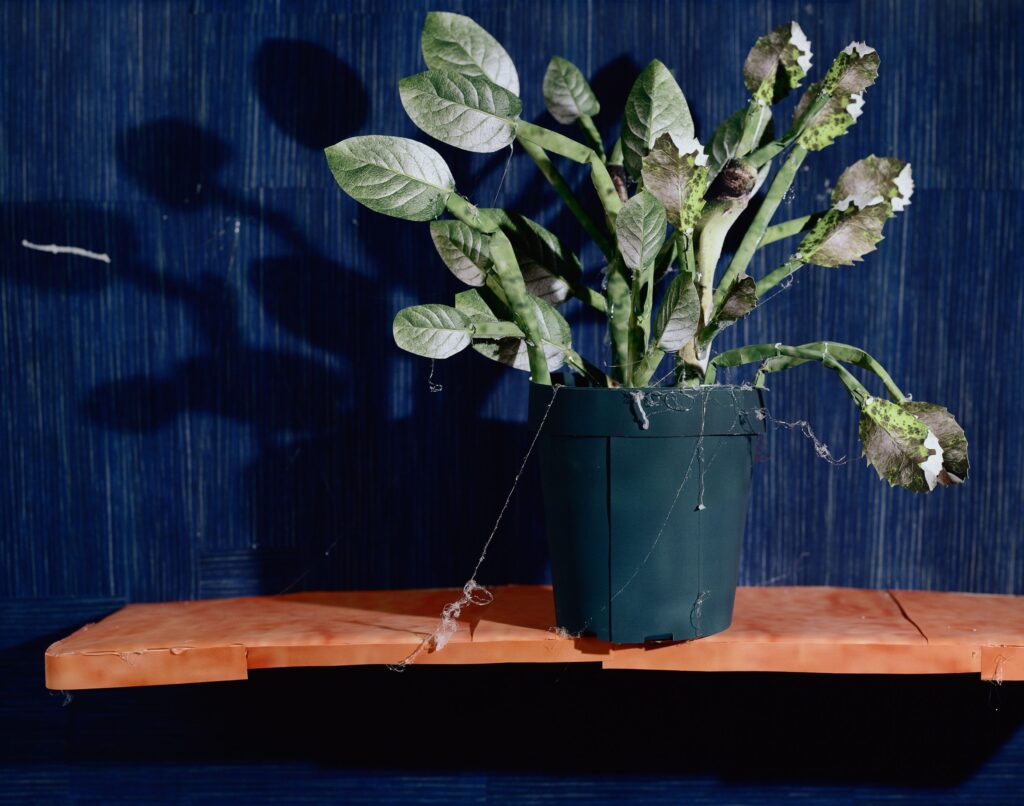
Gordon received an MFA from Yale in 2006 and soon began making intentionally rudimentary cut-paper constructions in the studio fashioned from inkjet print-outs of his own photographs of everyday items. [3] His subjects were close-up tabletop arrangements of flowers and food that retained much of the flatness of the paper from which they were crafted, but were bent and warped slightly to suggest a shallow depth. [4] At the outset, Gordon took his own pictures of the various items he wanted to use in his tableaux, but soon found that it was more expedient to source the images he needed online. If he wanted a picture of a watermelon, for example, it was quicker to Google “watermelon” than to procure an actual watermelon to photograph in the studio. This faster, more voracious working method also allowed for more improvisation and freedom in building his scenes. If he decides the composition needs a lobster or a seashell or a tulip, it is always readily accessible online. While Gordon’s use of found online images might be called an appropriative gesture, it resists the implicit critique characteristic of many appropriation-based photography practices. The artist does not use Google Images as a commentary on the impact of the internet on modes of visualization, but rather because it’s a readily available resource; it’s a tool that enables him to make the pictures he wants to make. Gordon’s unselfconscious engagement with the readymade archive that is the internet reflects a contemporary visual landscape in which images have become symbiotic with, rather than merely symbolic of, the physical world.
Throughout the early to mid 2010s, Gordon’s still-life compositions became increasingly complex and visually electrifying, growing from small groupings of rough-hewn fabrications into more abundantly populated arrangements bursting with vibrant patterns and supersaturated with bright colors. Still Life with Fish and Forsythia (2013) is a prime example of Gordon’s work from this time. The work presents a dynamic diagonal composition incorporating a grouping of pears, an assortment of fish, and several jugs filled with various plants and flowers, laid out and arranged across multiple levels.
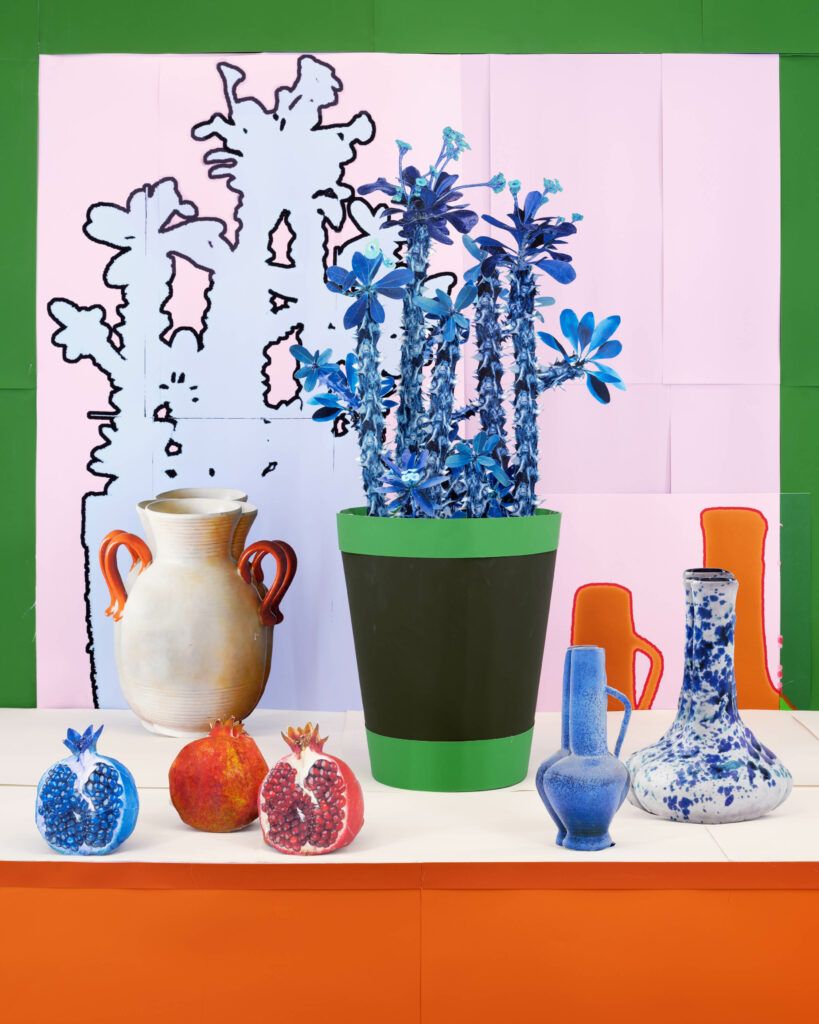
Around this time, Gordon had begun to recycle fragments of his own images back into his compositions, creating the disorienting impression of multidirectional shadows within their backgrounds. To generate the magenta outlines behind the forsythia branches and central jug in this work, for example. Gordon lit the tableau with stark directional lighting to create a heavy shadow, and took a preliminary photo. He then digitally altered the coloring of the shadow in that photo using Photoshop, and incorporated a print-out of the manipulated image back into the scene’s background, layering it atop the existing ground. He used the same process for the red tulip shadow, directing the light in the opposite direction. Prolonged viewing reveals the fault lines where test photos have been layered back into the arrangement as the seams of the print-outs leave discernable gridlines.
As in many of Gordon’s works, several of the objects pictured are tinted to unnatural psychedelic hues–luminescent cyans or bright pinks. This is the result of digital adjustments to the RGB proportions and saturations of his source material before those images are printed out and incorporated into the tabletop composition. It is as if Gordon inverts a conventional contemporary photographic process, doing all the work of digital post-production tweaks and alterations in the pre-production phase. Here, Gordon’s engagement with the digital comes on the front end of his process–such as sourcing his images online, or generating the digital enhancements and manipulations. While these various operations are executed within the computer, their results are ultimately exported out onto paper and included in the physical display in front of the camera; the resulting artwork is essentially a straight photograph. [5]
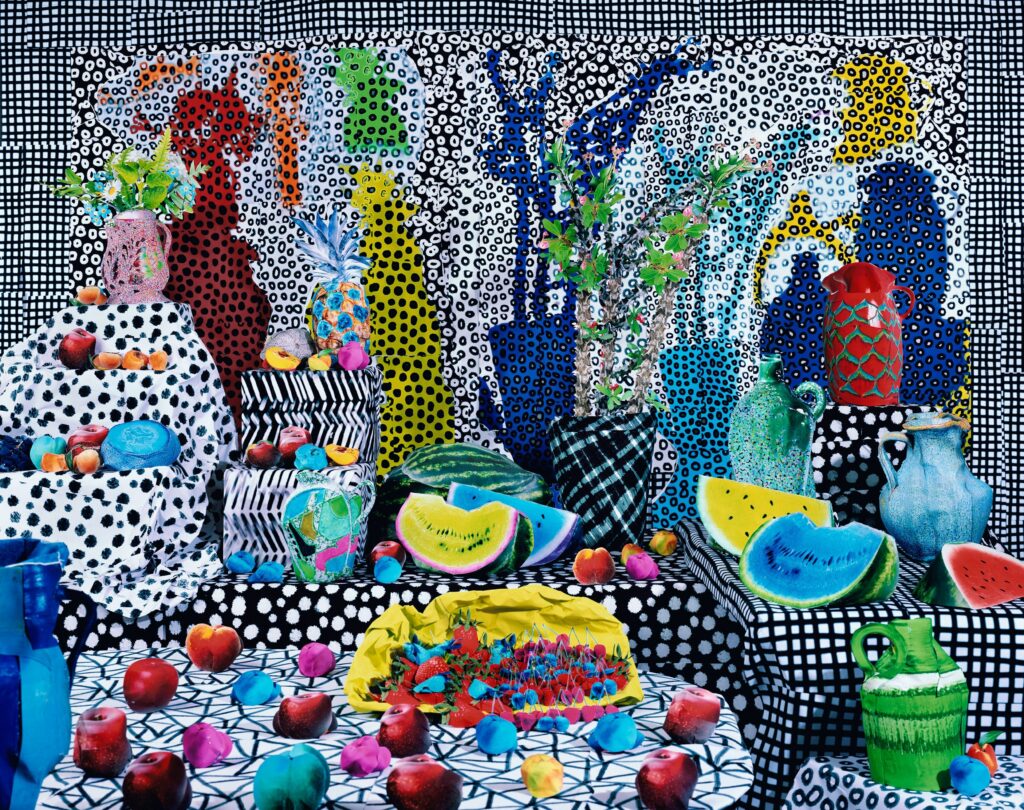
A group of works featured in Gordon’s 2014 solo show at the New York gallery Wallspace represents the crescendo of the artist’s maximalist turn. In works such as Summer Fruit and Still Life with House Plants and Pink Vase (both 2014), figure/ground distinctions all but completely collapse within a field of busy patterns and contrasting colors. The visual cacophony in such works provides a feast for the eyes, while intensifying the challenge of distinguishing between the fabricated objects and their silhouettes within the backdrop.
Over the last several years, Gordon’s compositions have gradually become more and more simplified as he has experimented increasingly with monochrome, outline, and flatness of surface. Some of this experimentation has been accelerated by his use of digital tools and iPad apps that allow him to easily manipulate photographic inputs digitally to achieve new visual effects. Much more graphic than scenographic, many of his recent works are so pared down as to retain only the slightest tether to their source imagery. Vase Shadow and Leaves (2017) offers only the mere suggestion of a frond, while Nectarine (2016) hints vaguely at a round fruit form identifiable only by the work’s title. But in such works, legibility is not the point. Instead, such pieces emphatically prioritize the relationships between form and color. They are expressive of Gordon’s renewed interest in painting and demonstrate how the concerns of painting can be explored through photography. Throughout the various undulations in visual style that Gordon has pursued over the course his career, he has remained steadfast in his commitment to still life as a subject, and intentionally engages the established art historical genre of still-life painting. Though still-life compositions can be found in the visual culture of various civilizations going back several millennia, many of the conventions of the genre as it is now understood were formalized during the Renaissance era. Dutch still-life paintings in particular provided vehicles for the conspicuous display of gratuitous excess. They often flaunted the types of goods suddenly made accessible by new trade routes (such as fine fabrics and exotic birds) as well as the tropical produce newly available year-round to the wealthy thanks to the inflow of goods from colonized lands in warmer climes.
Outside of fine art circles, much of the photography that engages the still-life mode today can be found in the realm of product photography, which operates by activating certain mechanisms of desire. [6] That desire then fuels the acquisitive motor of consumerism. It is no coincidence that the visual format of the still life is often used in advertising for home goods retailers, which utilize this format to sell products. The hand-wrought objects in Gordon’s still lifes subvert such desires from the outset—making clear that his tableaux, though appealing to the eye, are quite literally empty constructs. There is an almost lurid artificiality to Gordon’s seductive spreads—flowers that are unnaturally neon, electric blue apples and fish glowing a toxic purple—that thwarts any notion of imaginative consumption.
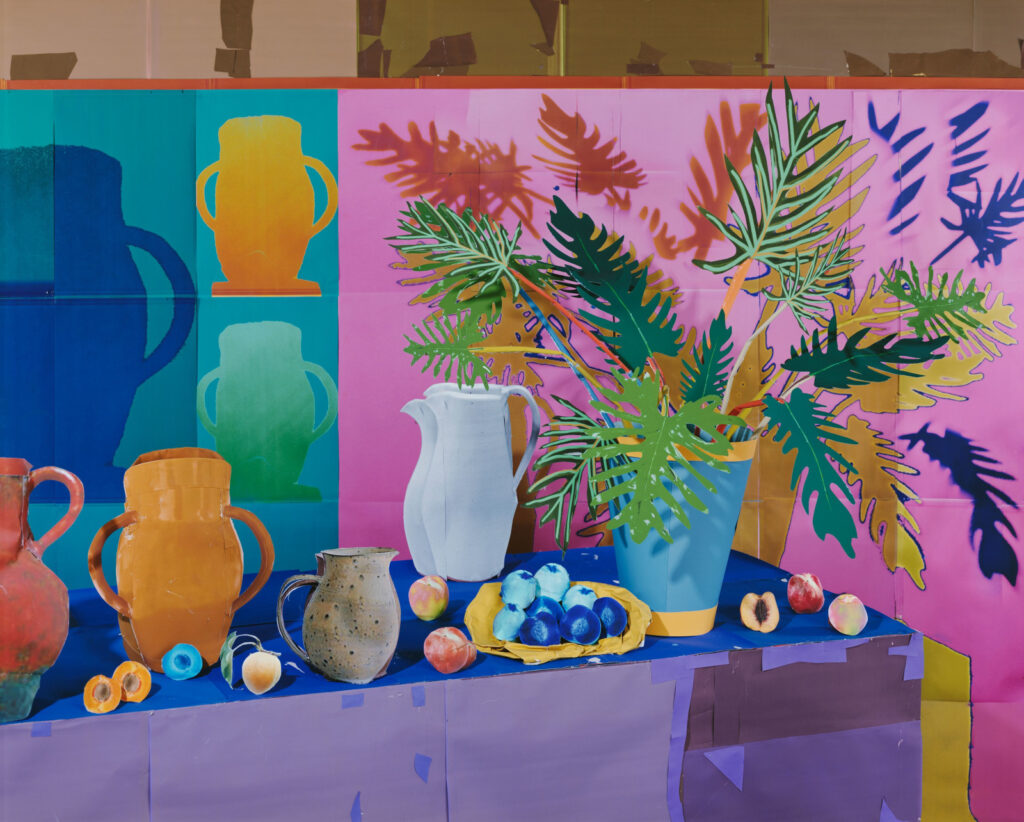
These associations, however, are merely the musings of this writer, and not the intention of the artist. Gordon avows that his is a purely formalist project, preoccupied first and foremost with visual experimentation and innovation. Though he draws some inspiration from still-life practitioners across history—Renaissance masters, Impressionists, Giorgio Morandi, and Henri Matisse, among others—Gordon largely approaches the format of the still life as a readymade in itself. It is an established genre with accepted conventions within the parameters of which he can improvise freely. “It’s interesting to be working in a genre while you develop and change as an artist,” Gordon says. “I’m actually not particularly interested in still-life; I’m interested in working on compositions. And that’s something that still-life allows me to do.” [7]
The genre is a useful frame because it provides a loose set of building blocks—a table, flowers, produce—which allows for Gordon’s innovation to come in his mode of representing them. The artist needn’t concern himself with continually reinventing the content of his photographs, but can focus instead on refining his approach to depicting that content. In Gordon’s words, “It’s not about what is pictured, but experimenting with how it is pictured. I’m not interested in the symbolism or meaning of objects, but am very interested in playing with visual impact. The meaning is in the looking. [Photographer] Stephen Shore talks about the idea of artmaking as a process of ‘thinking wordlessly,’ which really resonates with me. It’s when your brain is active and tingling in certain spots, but there’s no language; it’s purely a visual thinking.”
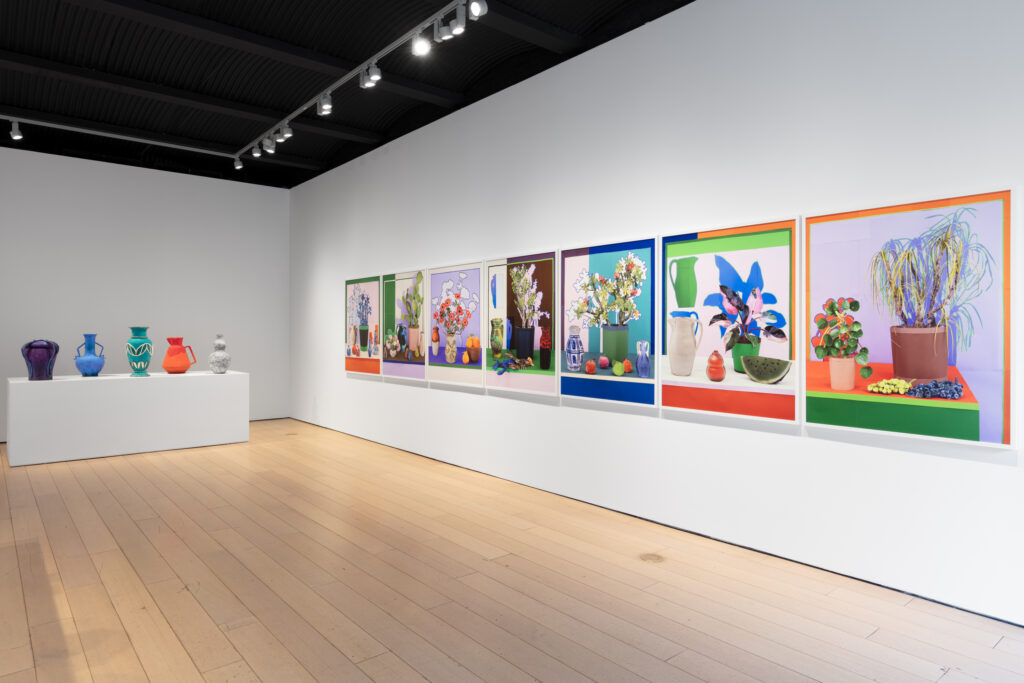
In this way, still life as a genre operates simply as a substrate upon which Gordon can enact his artistic process. The basis of that process is experimentation and play. By this point in his career, Gordon has tested so many different approaches that he has built up an arsenal of tools at his disposal. He is able to toy with a bevy of visual inputs, toggling each along a different spectrum: shallowness vs. depth of field, multicolor vs. monochrome, pattern vs. color block, sparse vs. crowded, volume vs. flatness, simplicity vs. complexity, object vs. outline, rough vs. polished, close-up vs. zoomed out, etc. These are the strings he can pull to achieve different effects. Gordon explains that his process often involves “turning one thing off to see what happens to the other parts.” When he simplifies the background and palette in works such as Blue Still Life with Crown of Thorns and Onions (2018) or Blue Still Life with Philodendron and Fish (2018), the subtle play between the artificial and actual shadows more easily catches the eye. Similarly, the absence of pattern in Philodendron and Nectarines (2017) allows the work’s color story to take on greater prominence.
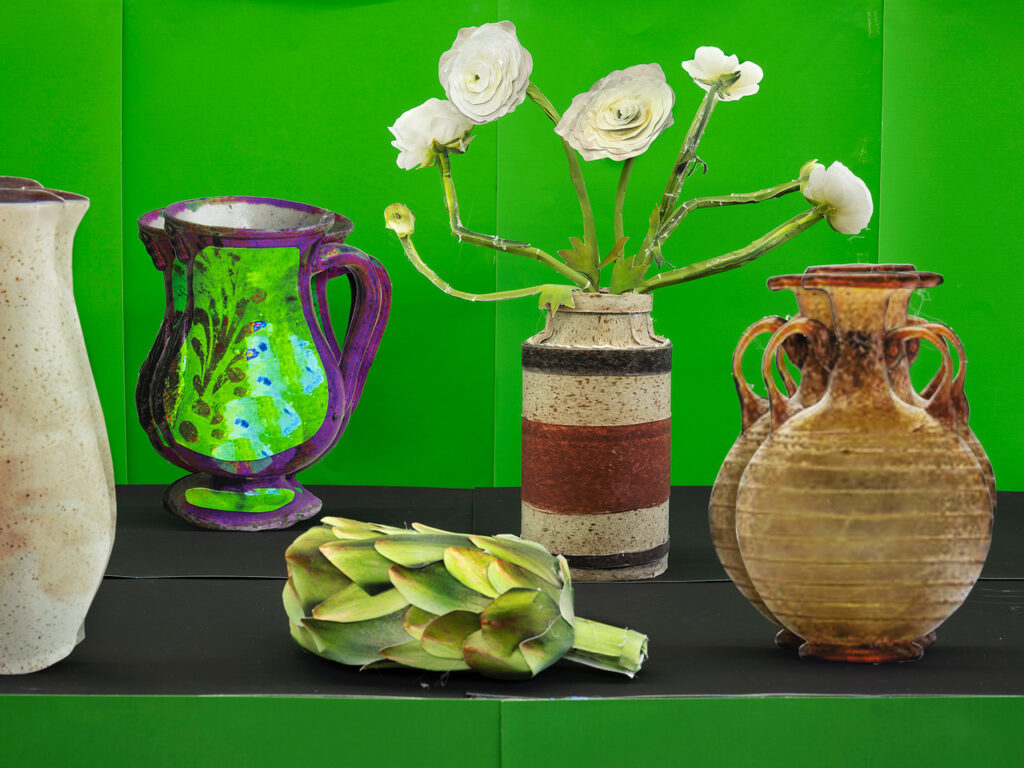
The unsung hero of Gordon’s practice is his hardworking stable of hand-crafted props. In this volume, a selection of these objects—primarily pots, planters, and vases—get their star turn. Typically serving as one actor among many staged within the artist’s sets, here each object is isolated and presented individually against a white ground, divorced from the context of the tableau. [8] Offering a peek behind the curtain, the verso of each page features an image of the selected object’s backside, which shows the unpolished, improvised reality of its construction. Clearly these props were intended exclusively for frontal viewing. Such a reveal not only fully dispels any lingering misconceptions as to the props’ objecthood and functional capacities, but also provides insight into the artistic process of Gordon-the-craftsman, which is guided by a mix of utilitarianism, expediency, and unintentional aesthetic pleasure. Scraps of paper lying around the studio are repurposed as support columns and hot-glued lines of bent wire give further structure. The reuse of studio castoffs gives rise to fortuitous moments, like when we see a printed image of a pot buttressing the back of an urn. Such sightings give rise to even more satisfying discoveries as readers glimpse these humble objects in the photographic scenes on the following pages. White Ranunculus and Artichoke (2021), for example, features both of the aforementioned objects, while Apples and Apricots in Blue (2018) includes a jar.
One pitcher, a clear favorite, seems to have made its way into several works, including Summer Onions (2016), Philodendron and Nectarines (2017), Simple Fruit (2016), Still Life with Fish and Oysters (2016), Still Life with Pears (2016), and Summer Still Life (2016). However, it appears smaller in some works than in others when compared to other nearby items. Gordon’s penchant for recycling and revisiting imagery gives the viewer pause; perhaps the scale shift is merely the result of camera positioning and the item’s depth within each scene, but perhaps Gordon has crafted several different objects of varying scale based on the same source image. Still Life with White Poppies and Blue Lemons (2018), after all, seems to include the same pitcher rendered in blue. These cross-referential scavenger hunts are diverting, but they can also key the viewer in more closely to the artistic choices Gordon is making while constructing each photograph.
Of late, a renewed interest in sculpture has ignited within Gordon. Recent projects that have directed Gordon back into a sculptural mode include his large-scale outdoor work in aluminum and steel, Blue Poppies (2021), installed on The Greenway in Boston, and the pop-up book Houseplants (Aperture, 2020) developed in collaboration with paper engineer Simon Arizpe. Gordon has now begun to consider creating more complete versions of his pots and vases crafted not only for one-sided viewing by a camera lens, but for 360-degree display in custom vitrines made with color-tinted Plexiglas. That after so many years Gordon’s sculptural image-objects would jump out of the space of the photograph and into the space of the gallery is perfectly in keeping with the artist’s bold and unwavering commitment to continually shifting the terms of his own practice.
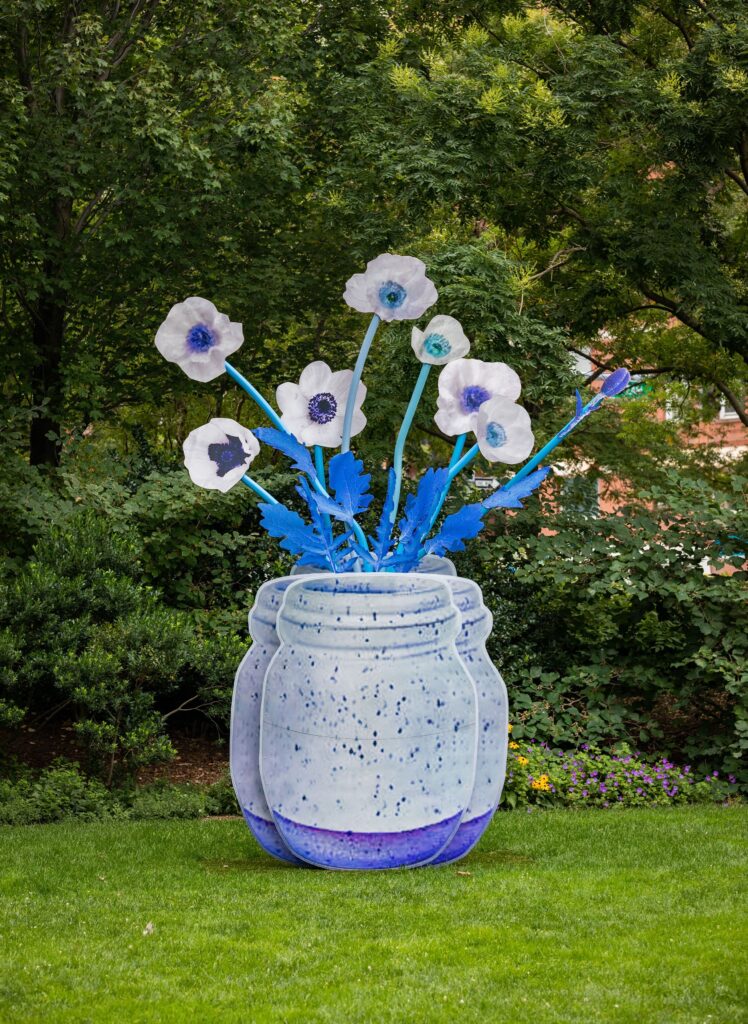
NB: unless otherwise noted, all quotes attributed to Gordon are from a conversation with the author.
Susan Thompson is a curator and writer working in the greater New York City area. She is currently the Director of Grantmaking and Curatorial Research at VIA Art Fund. From 2020-22, she served as project manager for Simone Leigh: Sovereignty presented at the U.S. Pavilion as part of the 59th Venice Biennale. This project included the momentous Loophole of Retreat: Venice symposium, which gathered 70 presenters and 700 attendees in Venice for three days of talks, performances, film screenings, and conversations. From 2009-2020, she worked as a curator at the Solomon R. Guggenheim Museum, New York, where she organized numerous exhibitions, including Implicit Tensions: Mapplethorpe Now, Simone Leigh: Loophole of Retreat, and Anicka Yi: Life Is Cheap. She is the author of Ghada Amer: Painting in Revolt and Louise Bonnet: Vagabond, and has contributed essays to numerous monographs, exhibition catalogues, and scholarly volumes. Thompson has also held positions at the Whitney Museum of American Art and in Columbia University’s Department of Art History and Archaeology. She holds a BA in art history and political science from the University of North Carolina at Chapel Hill and an MA in modern art from Columbia University.
NOTES
[1] Gordon’s spreads of fruit call to mind those of Post-Impressionist painter Paul Cezanne, who attempted to render his subjects from multiple vantage points simultaneously. Gordon’s faceted paper constructions achieve a similar effect.
[2] The work of Thomas Demand, who creates and photographs his own ephemeral paper constructions, was an important influence for Gordon. However, Demand puts much effort into the representational fidelity of his paper models; they are more meticulously and painstakingly executed and give fewer visual hints of their own artifice to the viewer. Another important distinction Gordon notes is that Demand’s “is a political project and mine is absolutely not.”
[3] Gordon cites the slapdash papier-mâché objects that populated Claes Oldenburg’s installation The Store (1961-64) as an inspiration for his early crumpled paper constructions, noting in particular that Oldenburg’s handmade objects did not have to convincingly resemble the items they were mimicking in order to signify them.
[4] At the same time, Gordon began making portraits featuring faces cobbled together from mismatched and disproportionate fragments. These works, with their Cubist-adjacent distortions and Frankensteined creatures would come to form another branch of the artist’s practice focused on the human visage, which continues today.
[5] For many years. Gordon shot all of his works on a large-format 8×10 camera, but has begun more recently to shoot primarily with a digital camera. As he was coming of age as an artist, there was much handwringing in photography circles about digital equipment, and to an even greater extent the use of Photoshop, which were considered unserious in the realm of fine art photography. Gordon was unconcerned with such stigmas and his choice to stick with the large-format film camera for so long was entirely aesthetic, not romantic. When the quality of digital photography advanced to meet his standards. he made the switch. “Once the technology was there,” he says, “it was a no-brainer. It was never about ‘purity’; it was always about the final image. A question of: what tool will achieve the thing I want?” A digital camera—or Photoshop, or the other digital applications he now uses to great effect—is just another tool that enables him to make the pictures he wants to make. For him, there is no hierarchy among them: the camera, the glue gun, the X-Acto knife, and the iPad. When Gordon started adjusting the colors of the images used to create his tableau objects (see: Nectarines in Orange and Blue (2011), he purposefully did so in an exaggerated way such that the manipulation was obvious. He didn’t want his use of Photoshop to feel hidden as if he accepted the stigma around it. Guided perhaps by a similar impulse, Lucas Blalock, an undergraduate classmate of Gordon’s from Bard College, was creating uncanny digital photographs around this same time that were conspicuously edited in Photoshop with copy/paste and mark-up tools.
[6] Many of the images Gordon borrows for his constructions are in fact drawn from product and stock photography, imagery produced as part of the visual economy of advertising.
[7] Gordon capitalizes on the fact that still life is such a well-known art historical mode that it enables viewers to easily look past content to form. “Most viewers are familiar with that history whether they’re experts on it or not,” he says. “Those images are already layered into peoples’ minds. It’s a known genre that can then do my thing with.”
[8] Though photographing arrangements of such objects is the backbone of Gordon’s artistic practice, the images of the props presented here are considered documentation rather than artworks.
Banner image: Daniel Gordon, Succulents and White Orchid, 2023.
All images courtesy of the artist.

